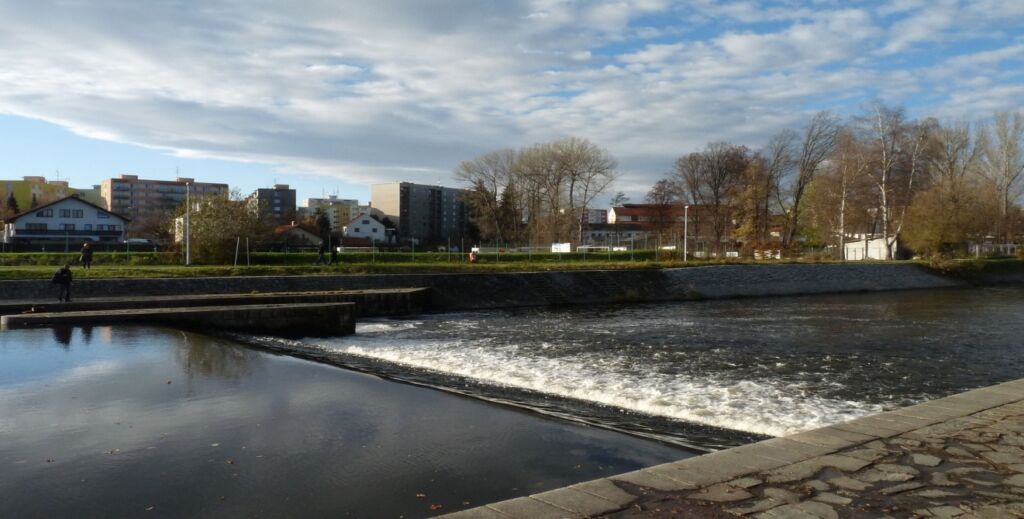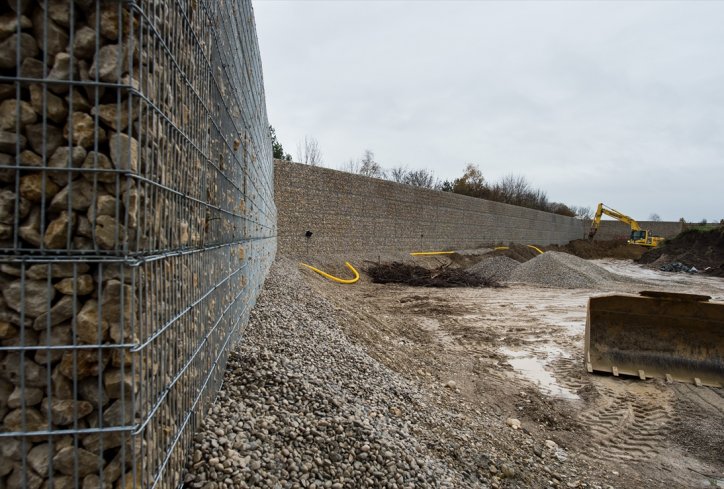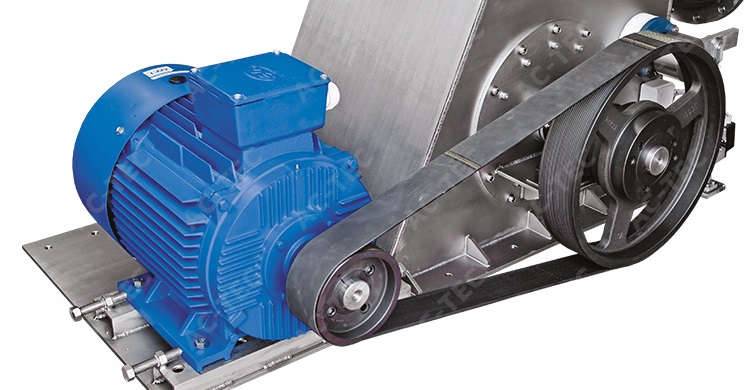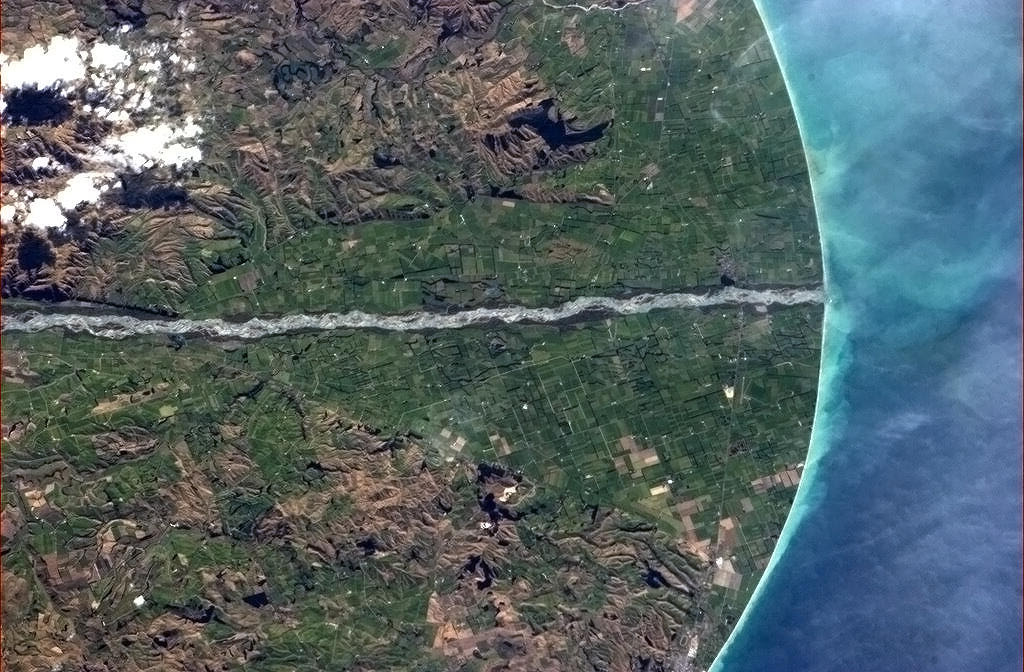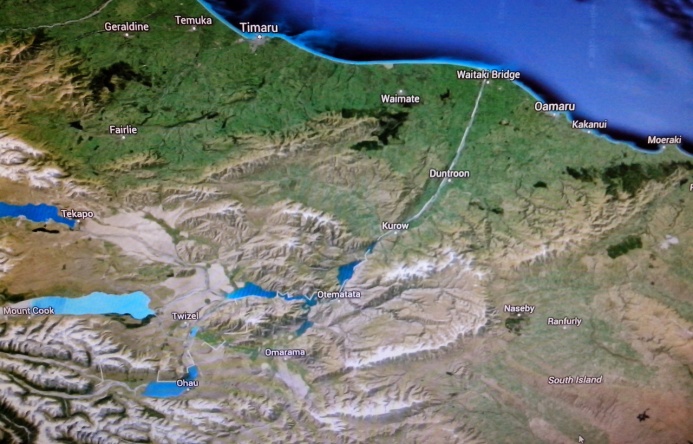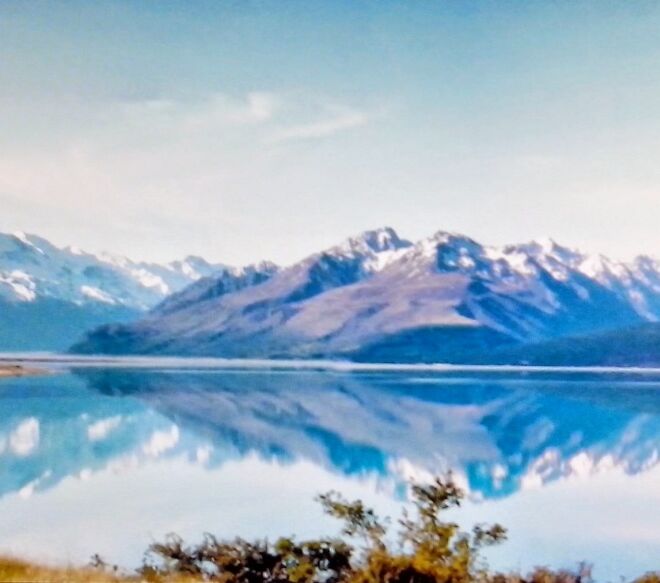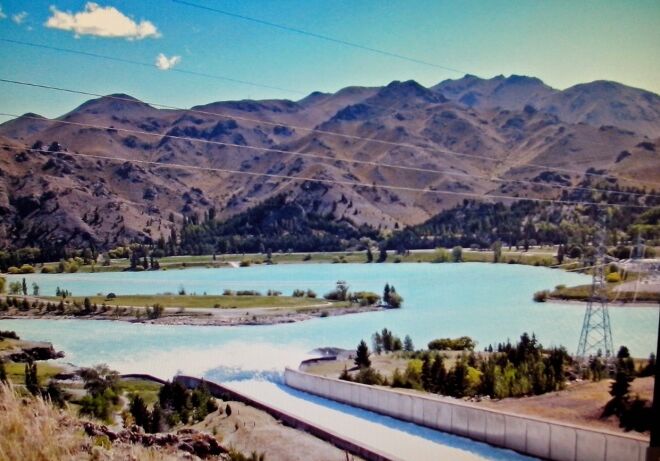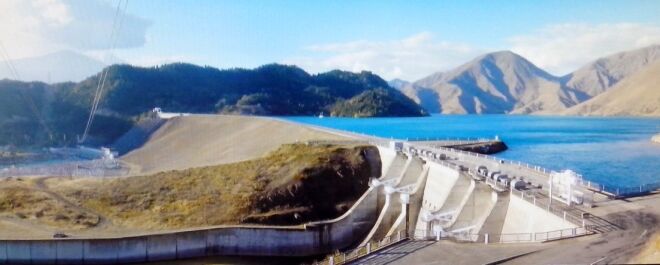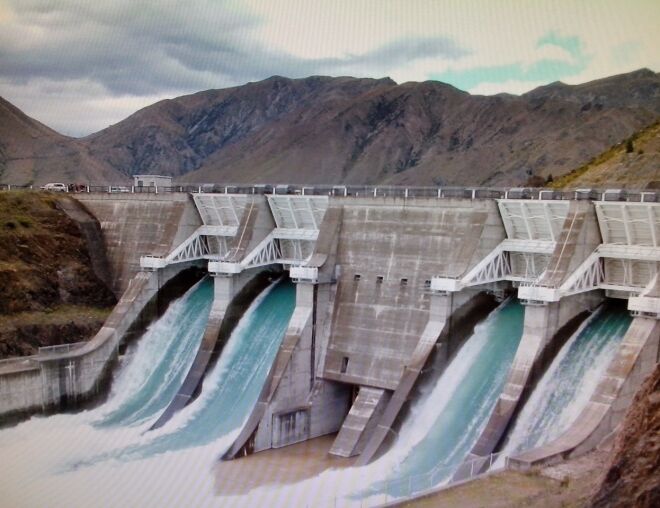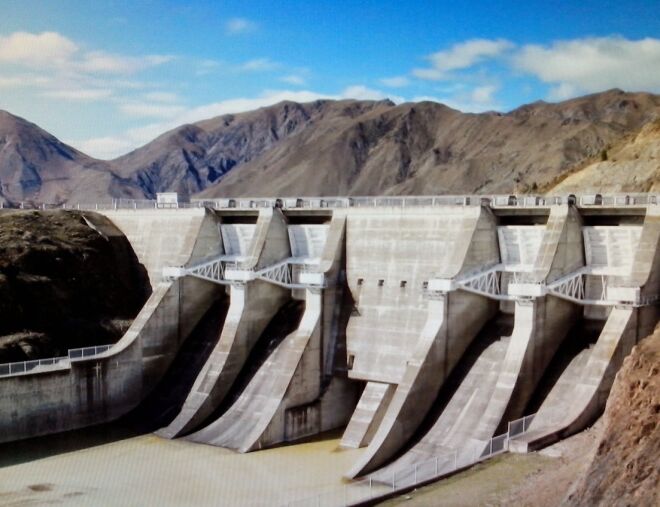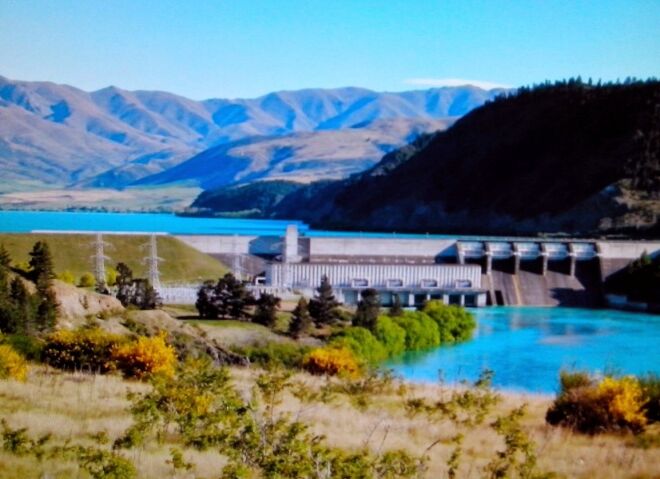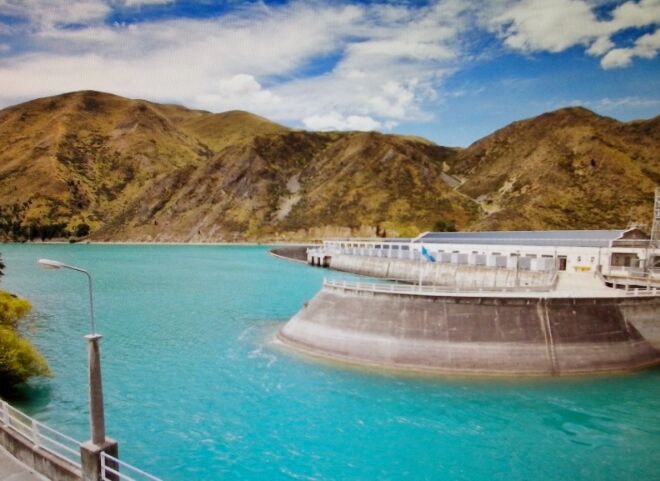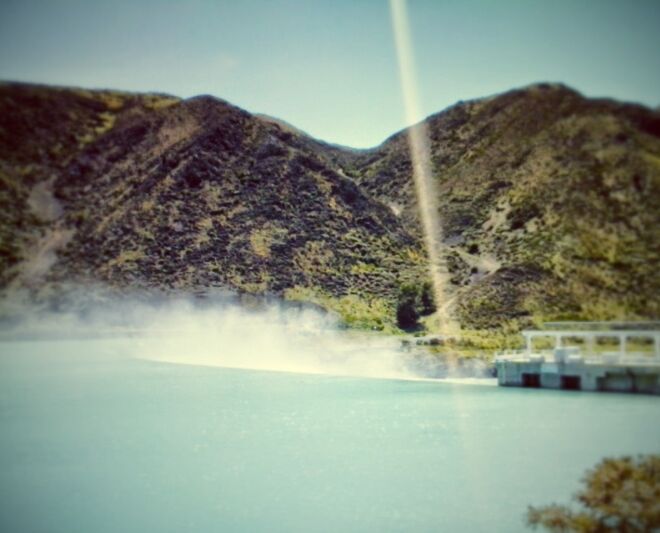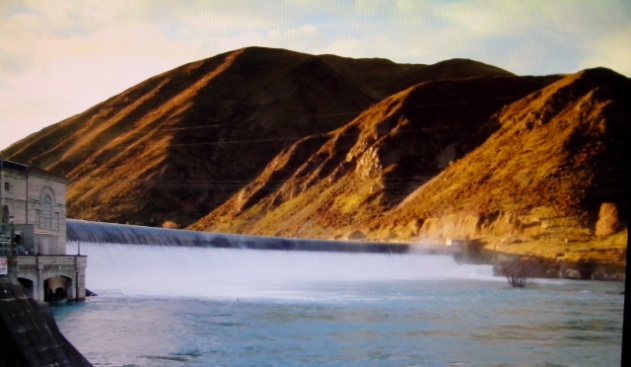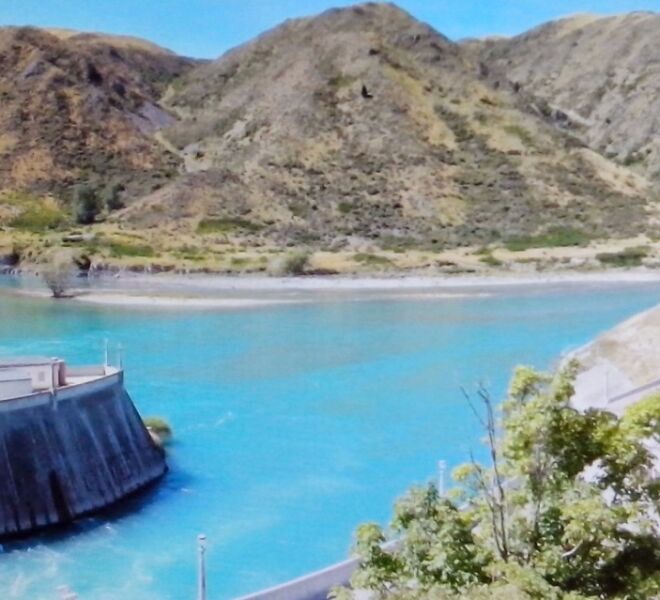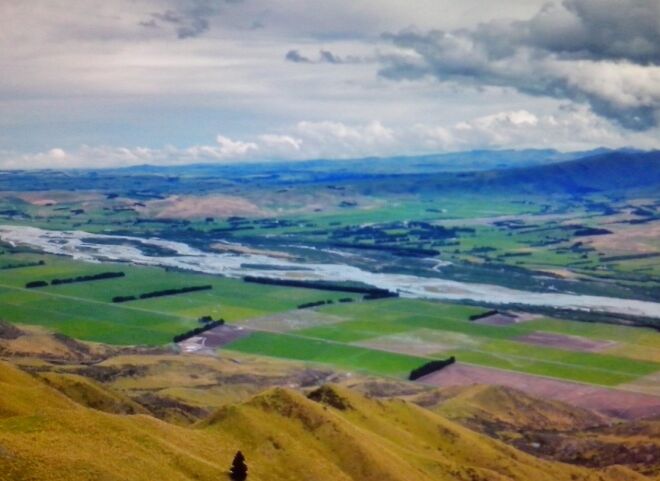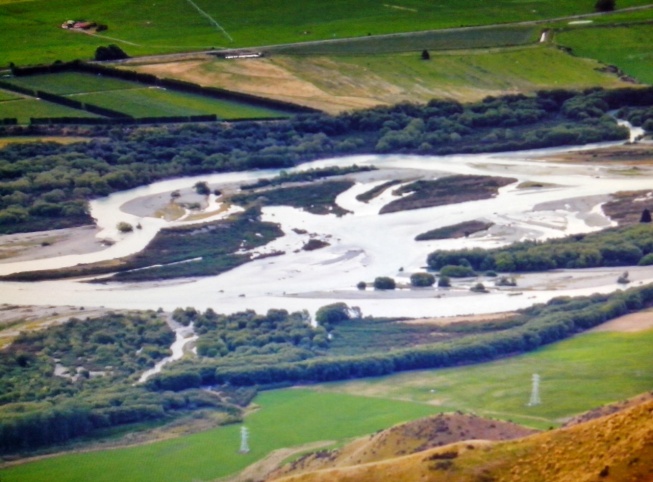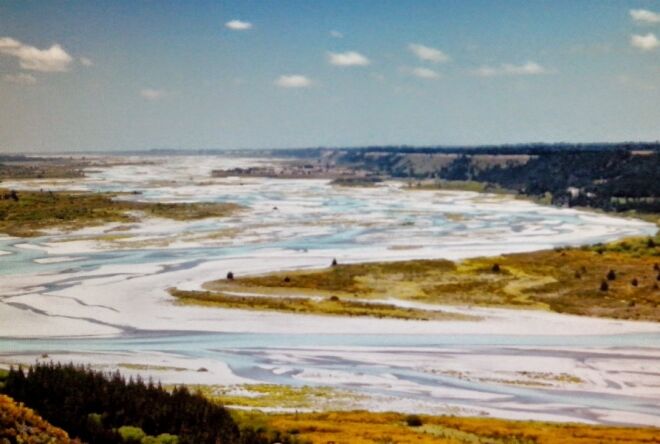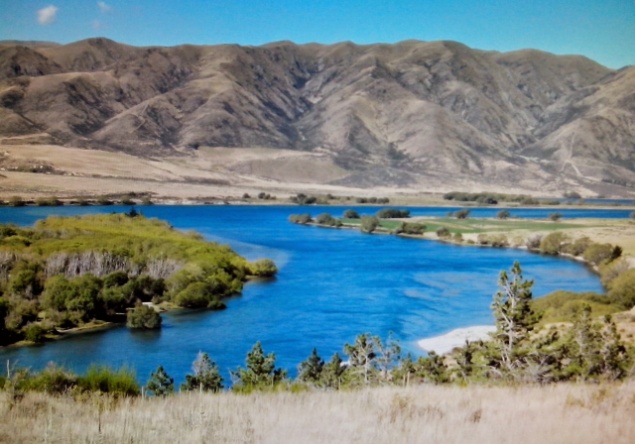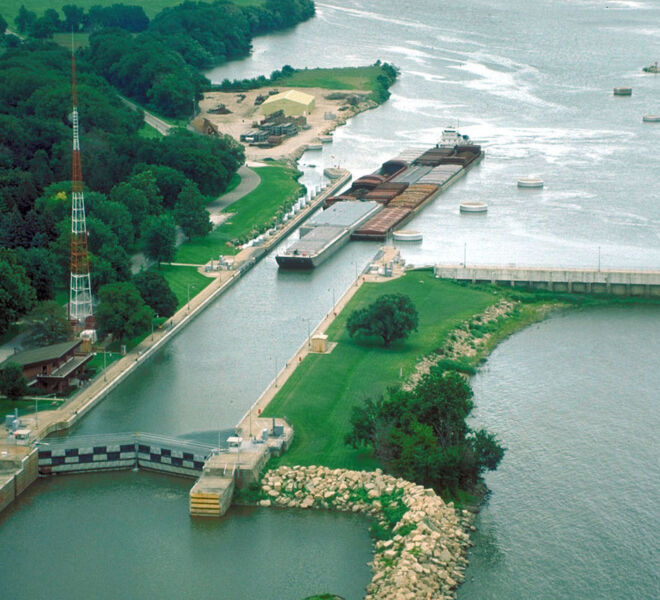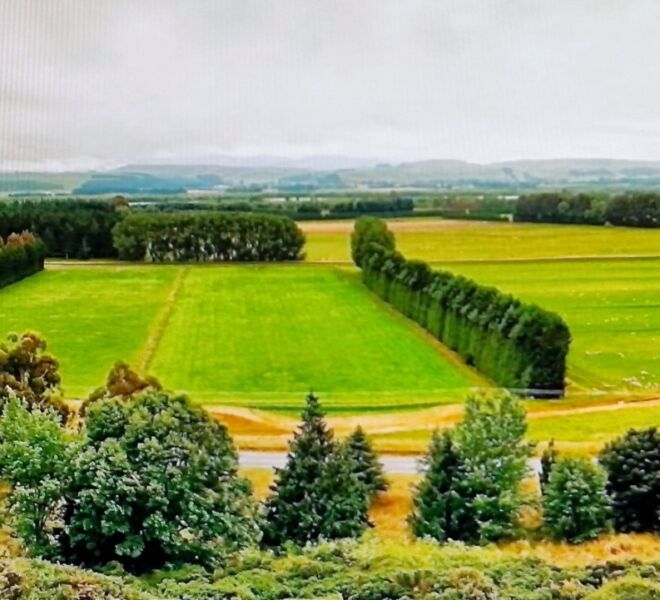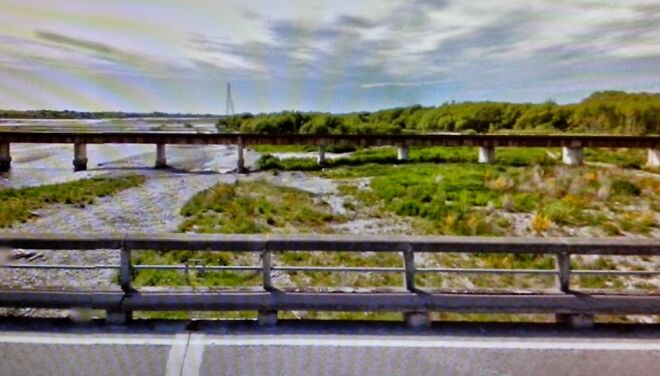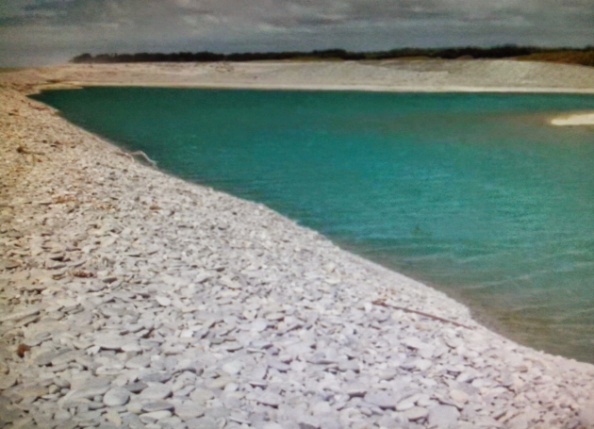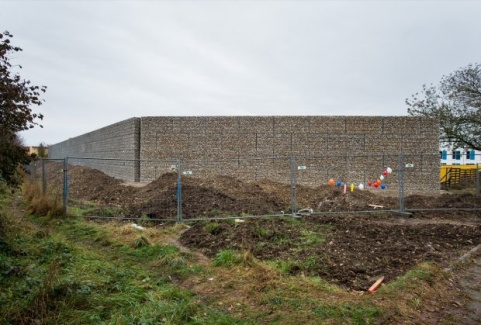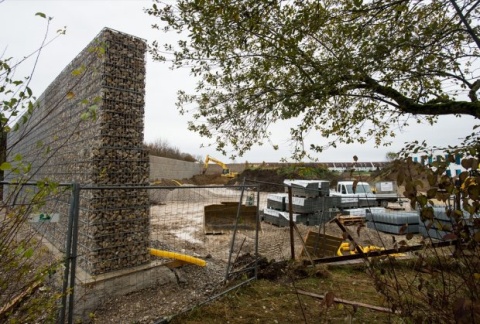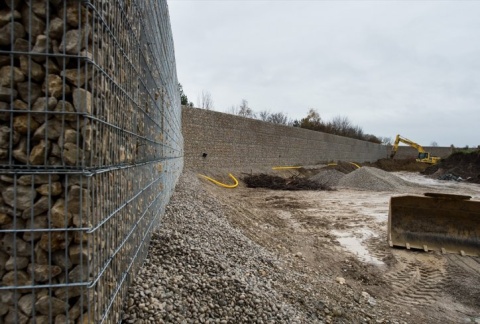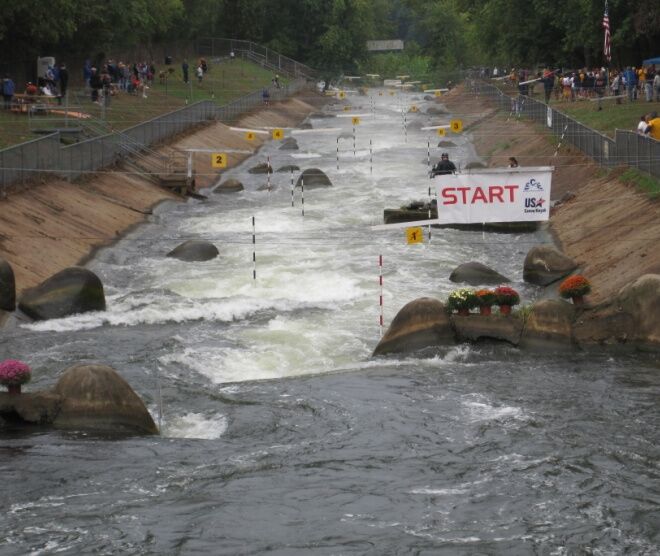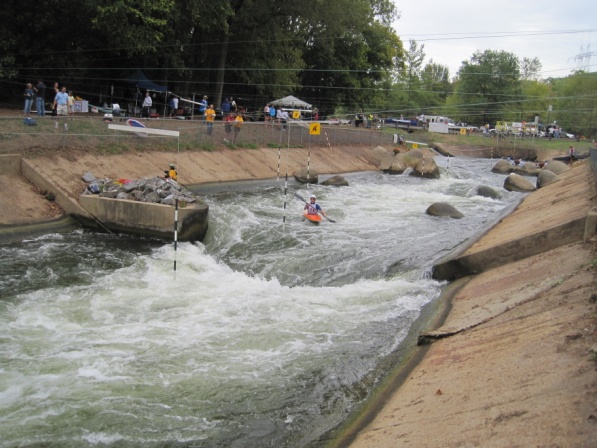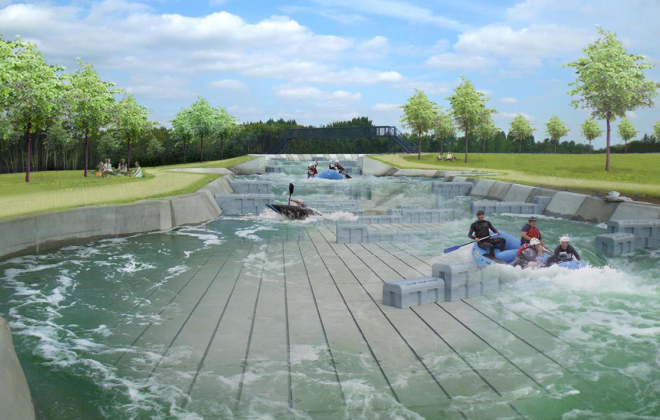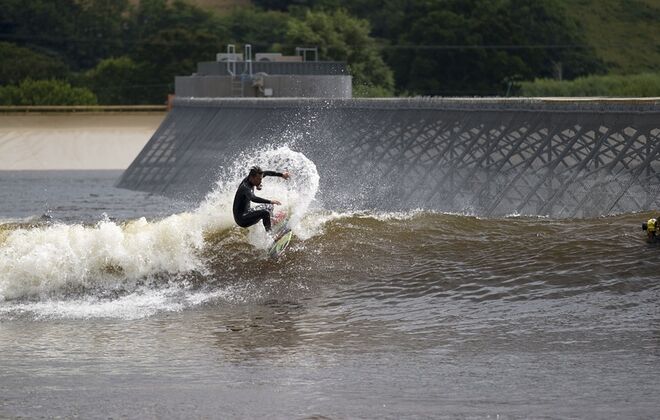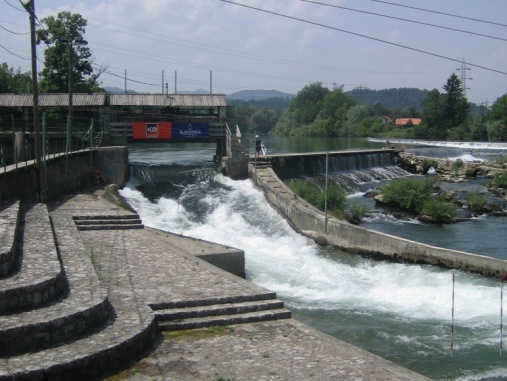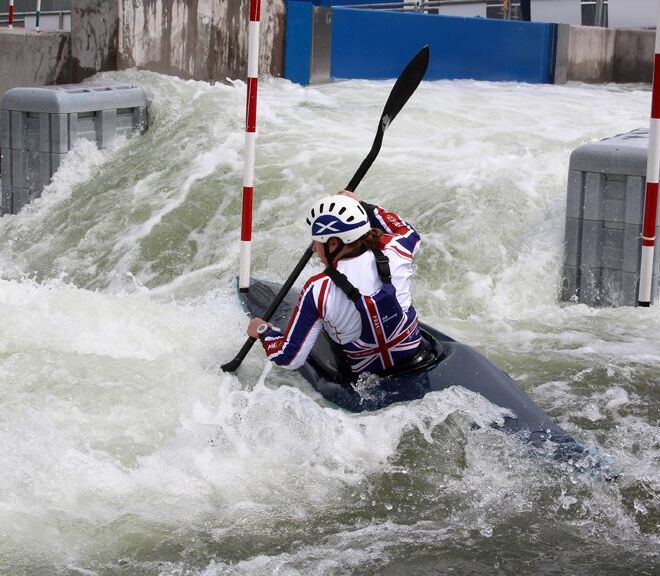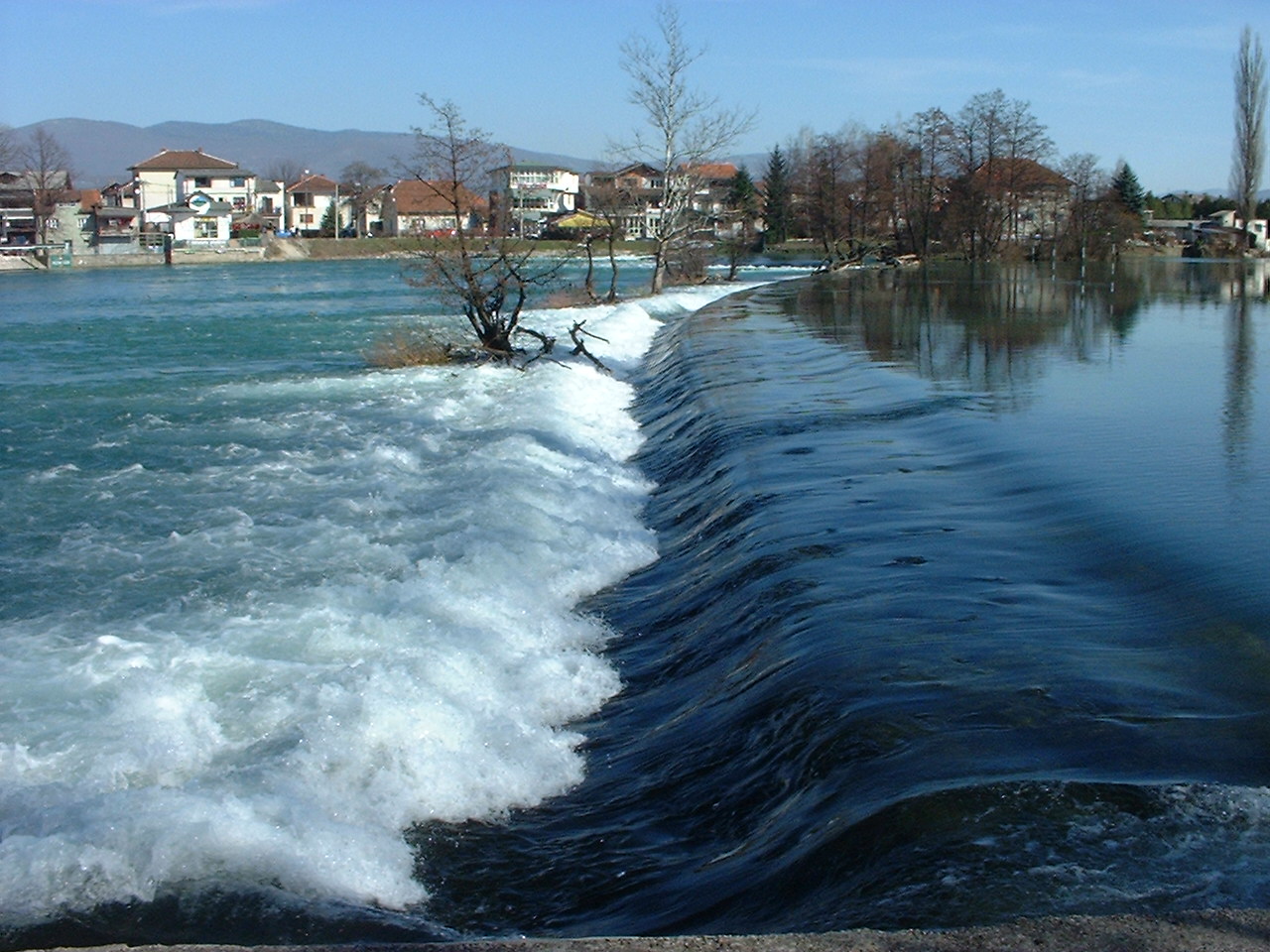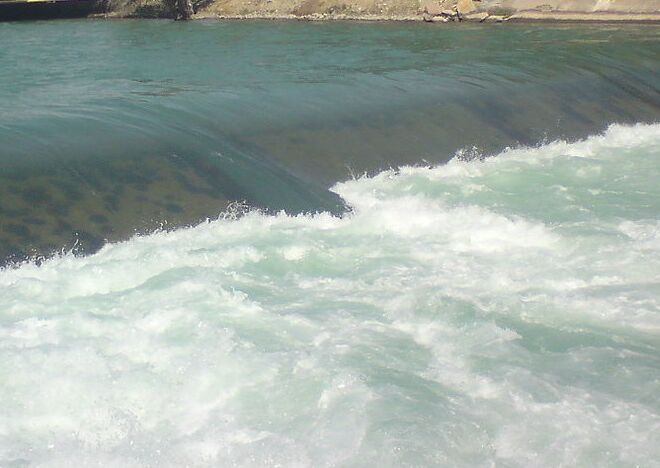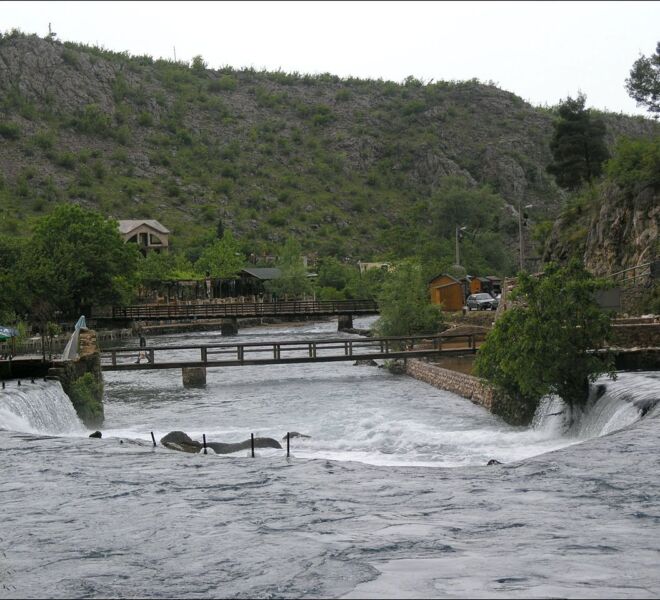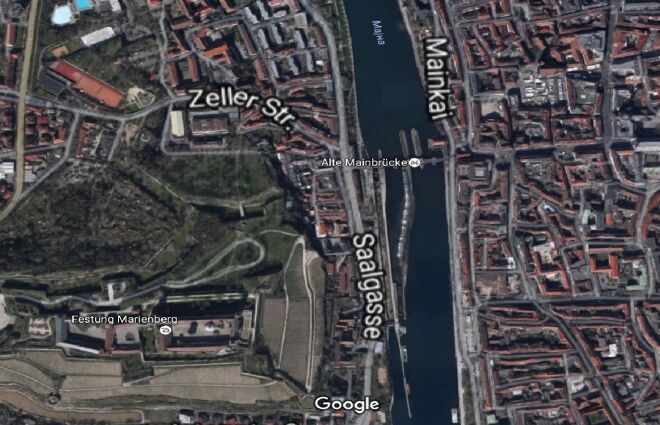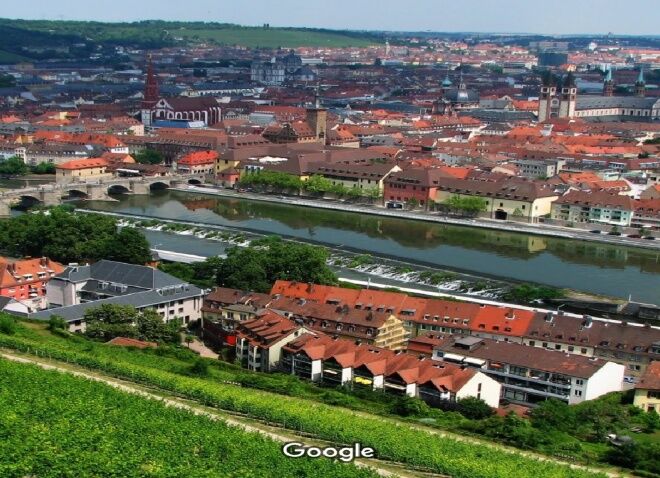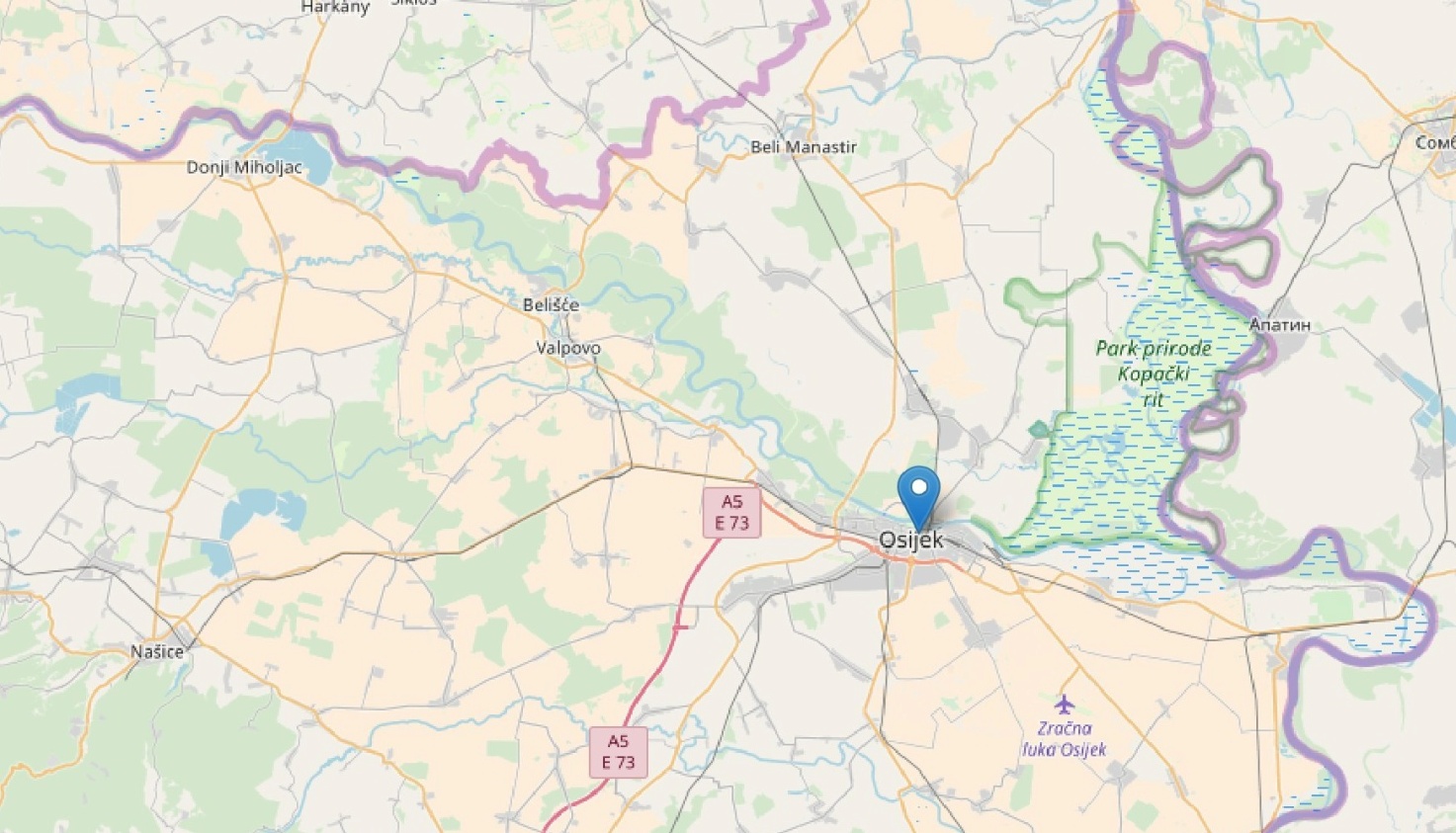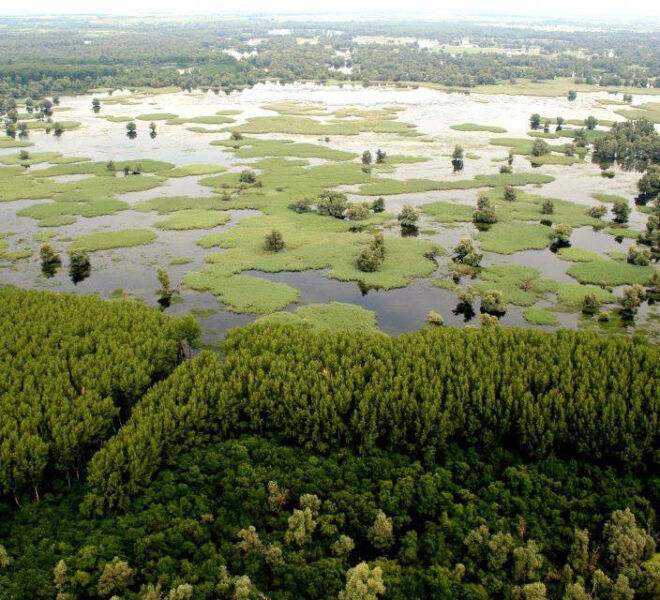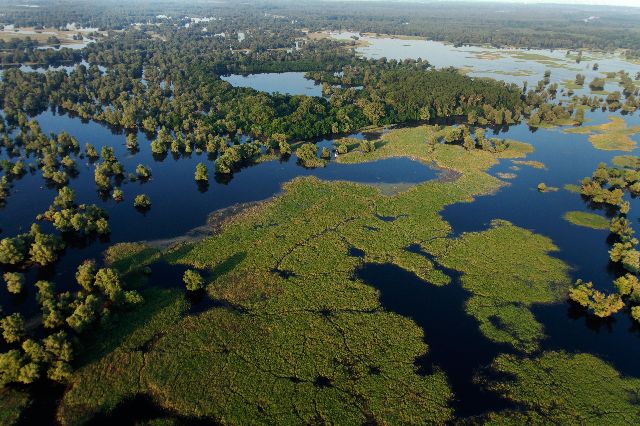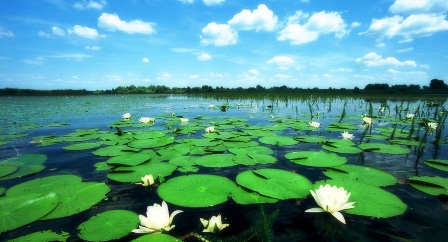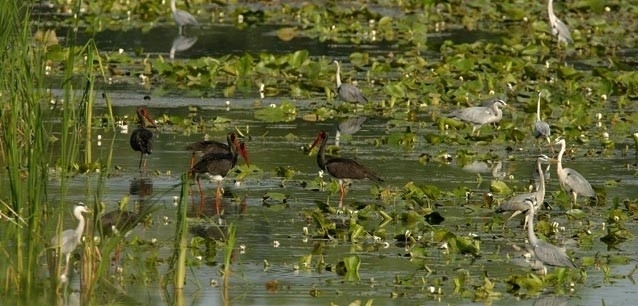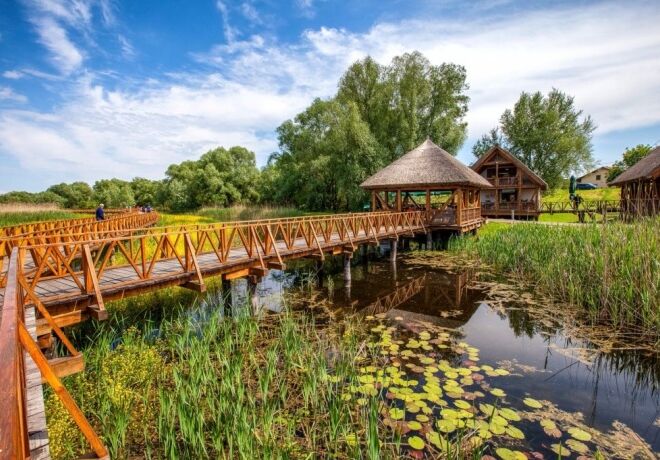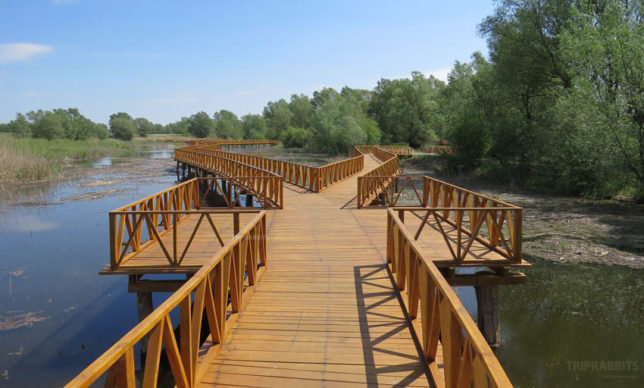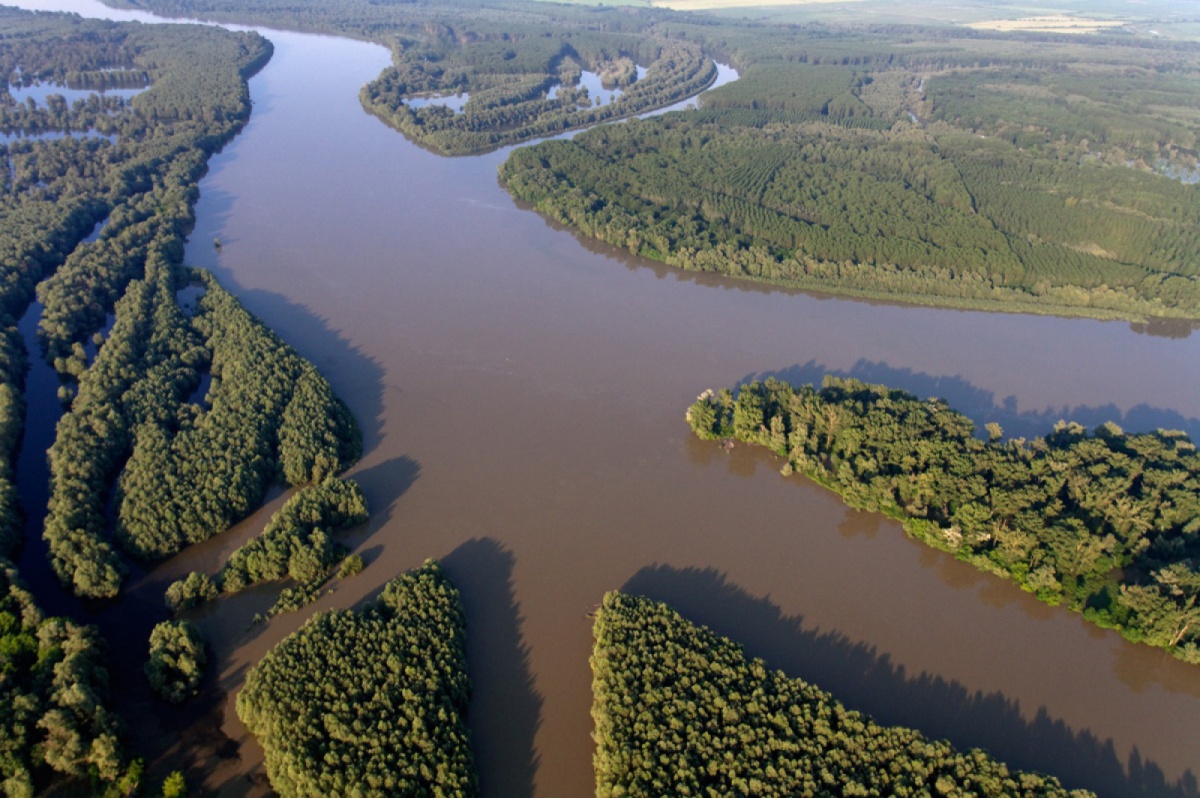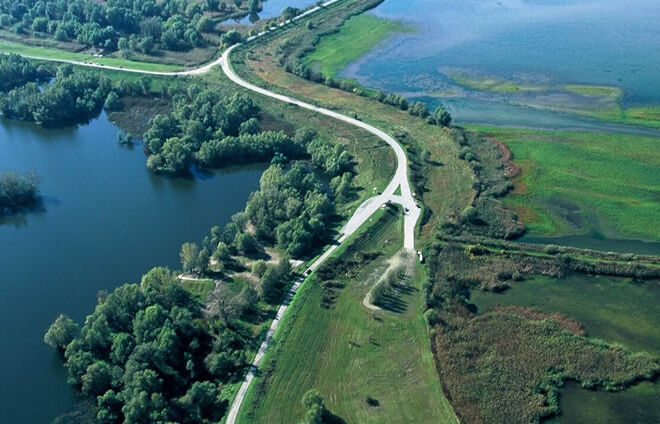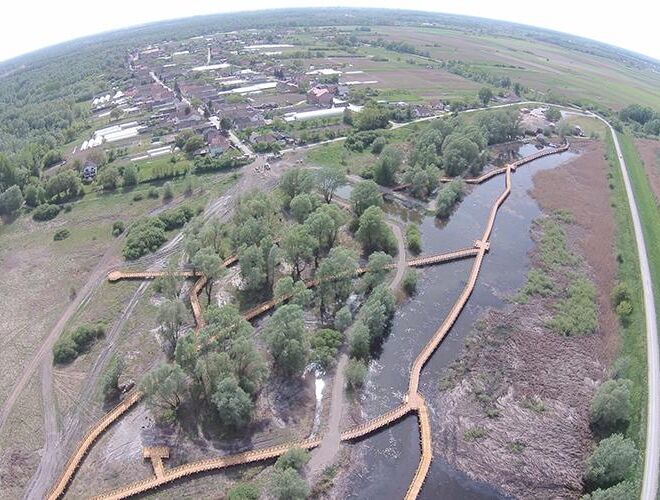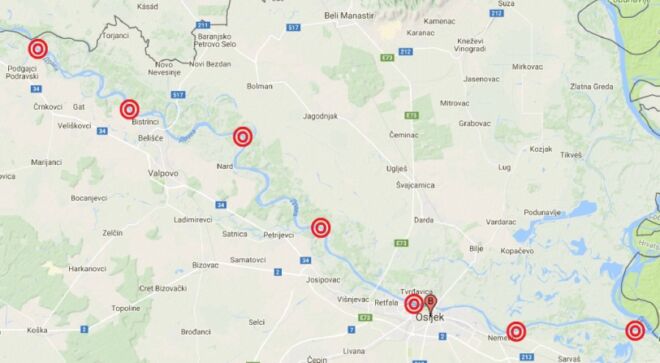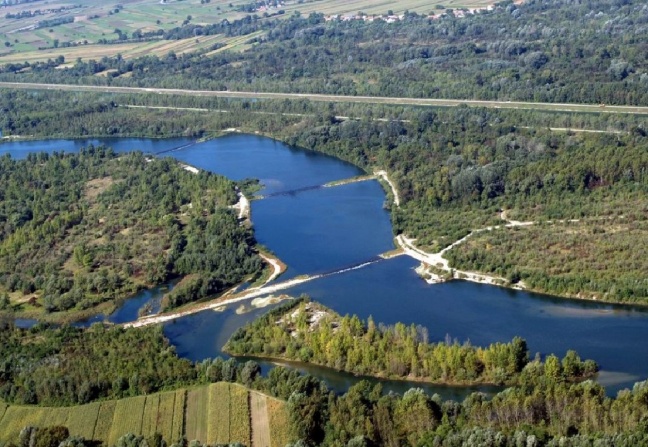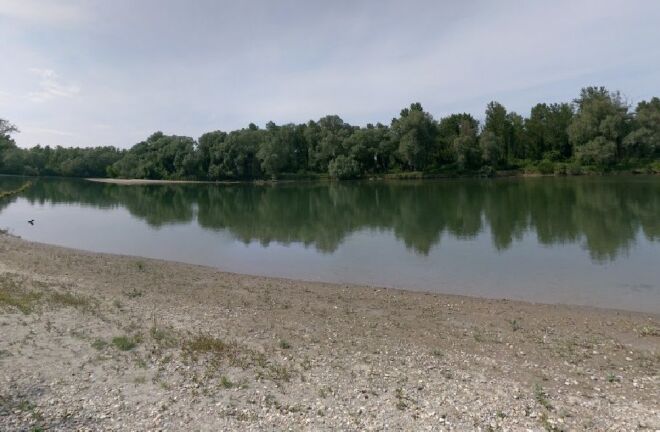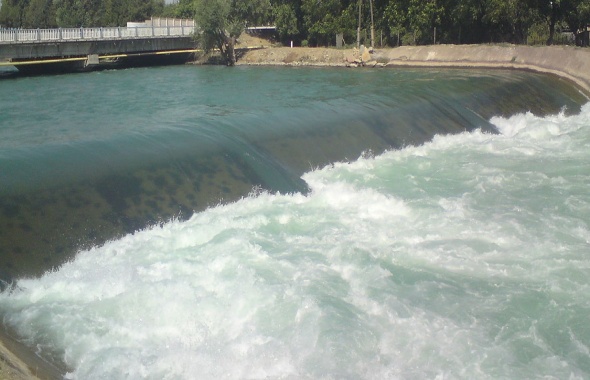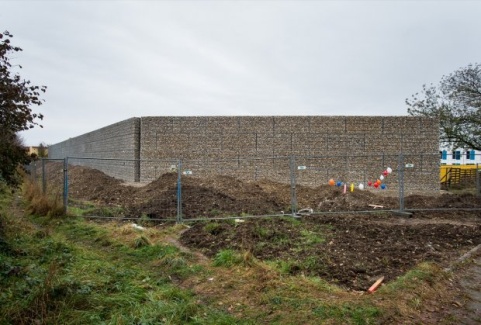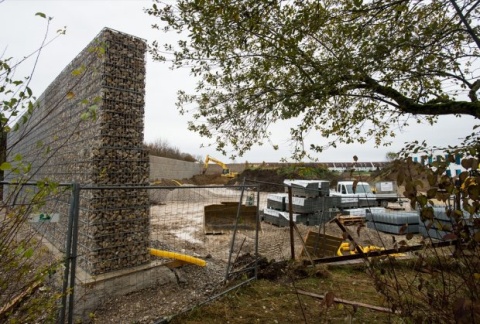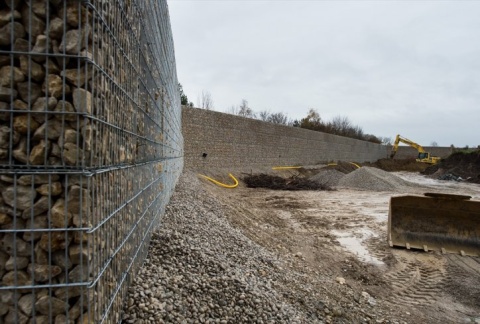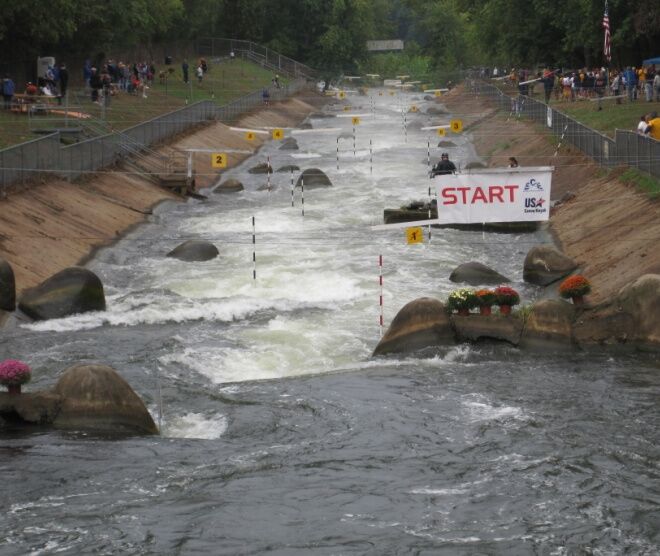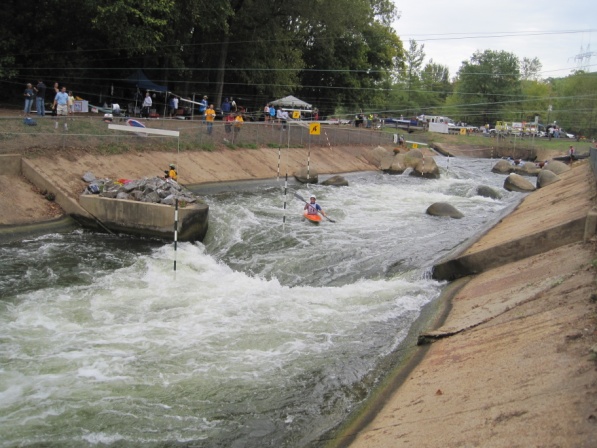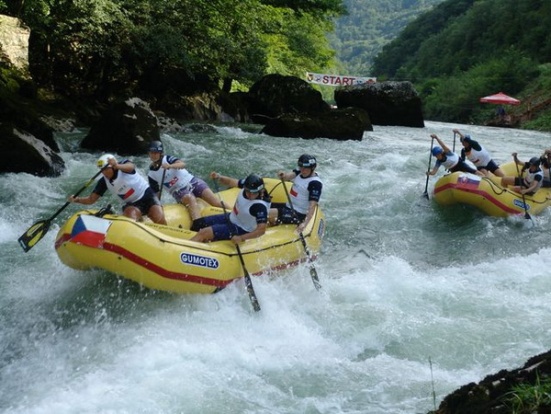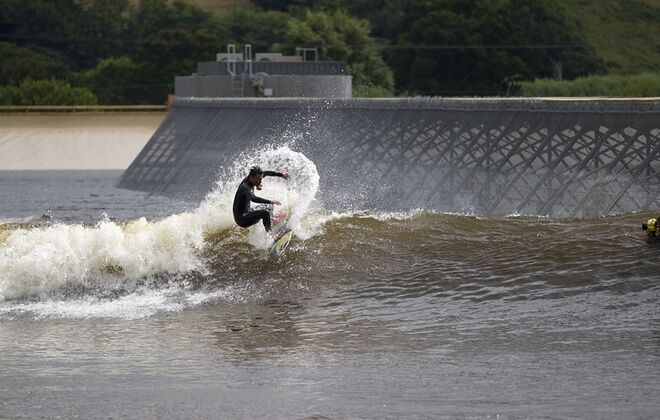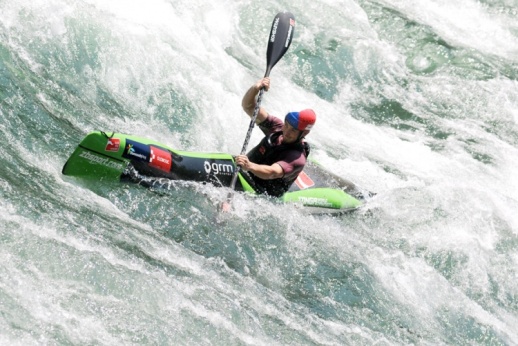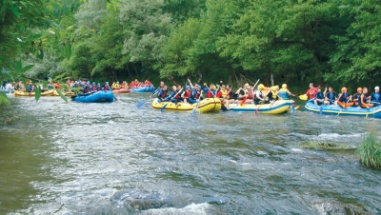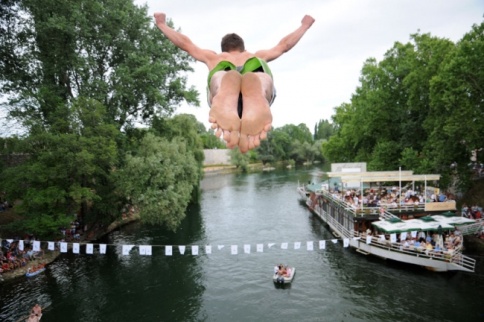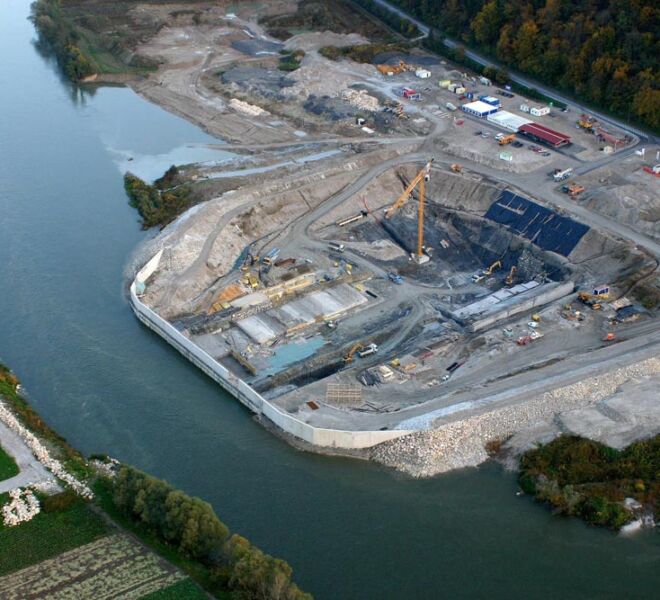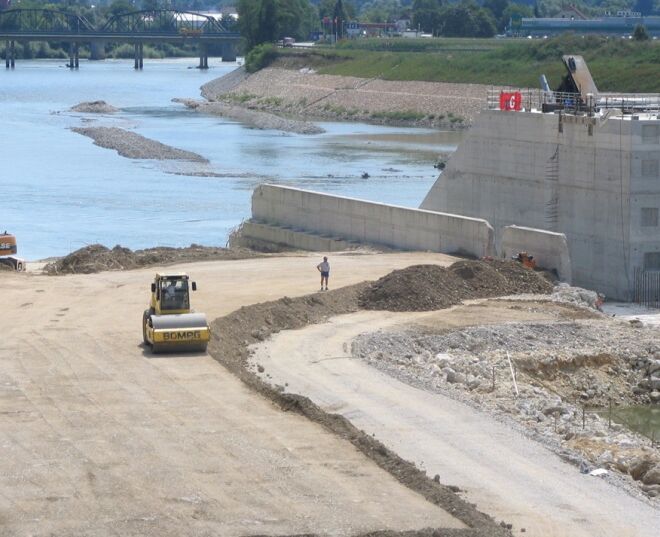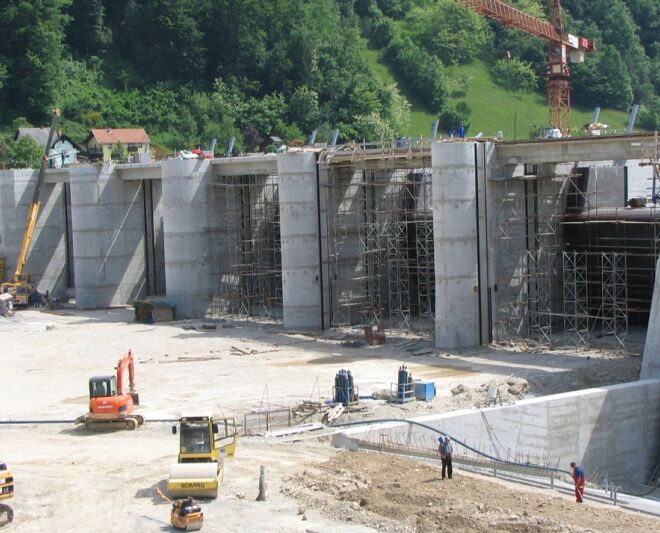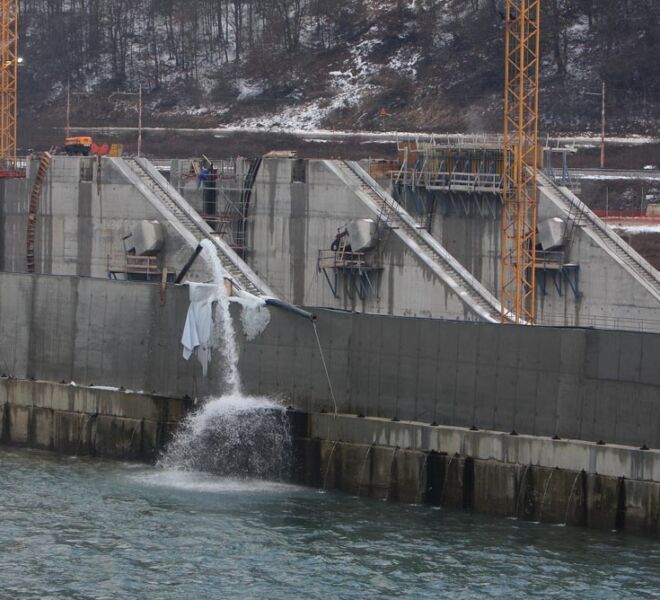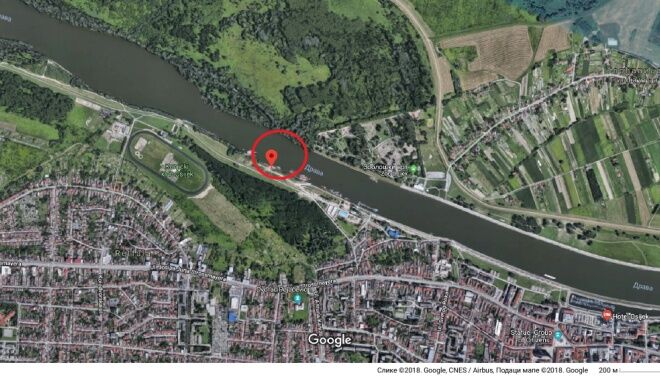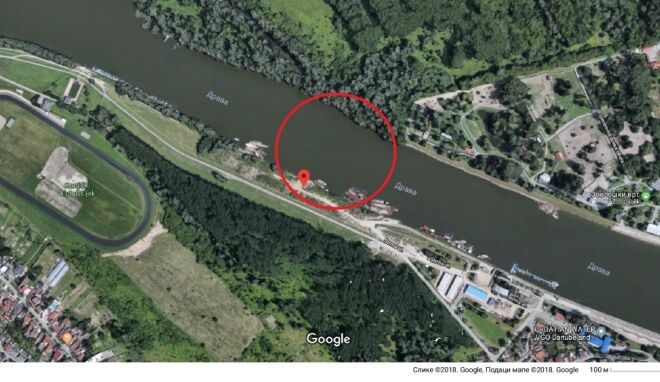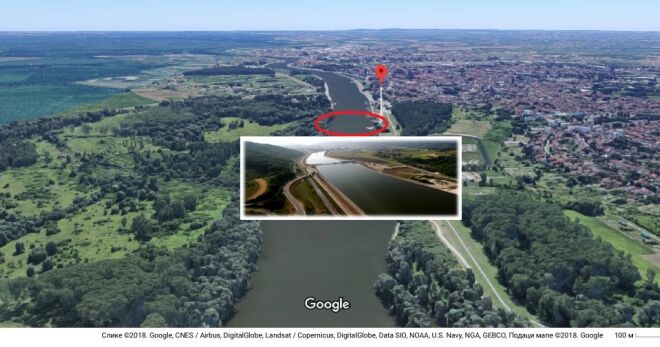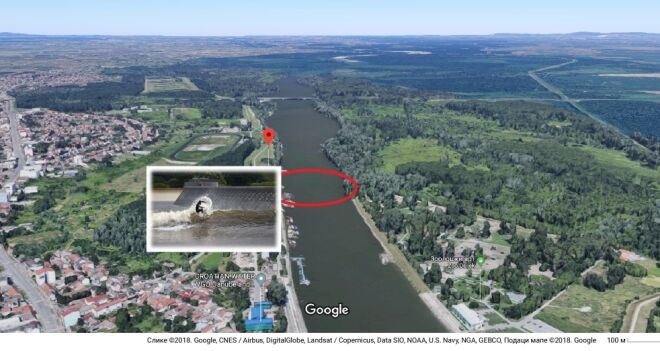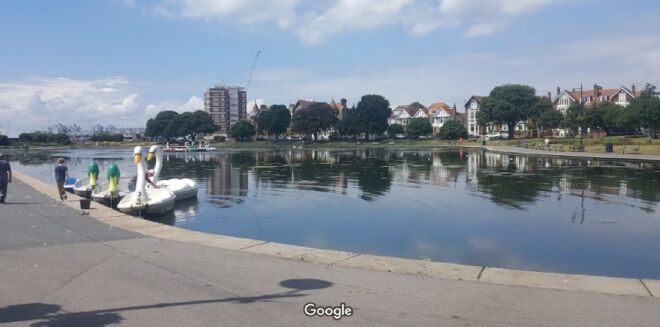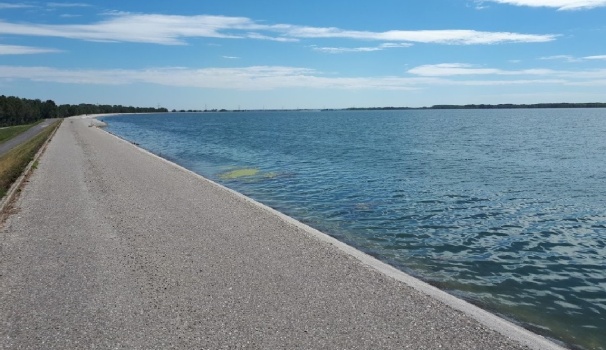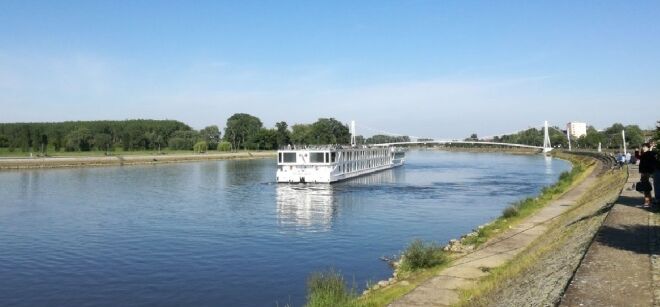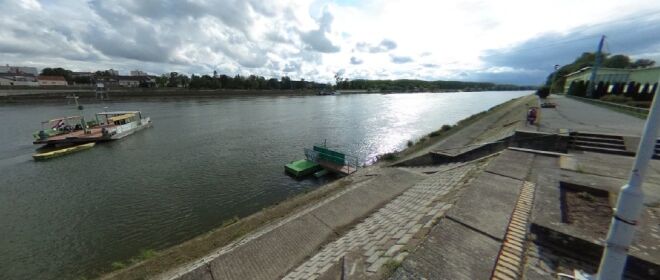Waitaki River in New Zealand
The length of the unused Waitaki River, from the lower dam to the mouth of the Pacific Ocean, is approximately 70 km.
The height difference of the river fall, from the last dam to the level of the Pacific Ocean, is approximately 200 m.
In the upper basin, there are already dams with reservoirs to control the flow of water in the river.
Existing dams with reservoirs in the upper Waitaki River Basin
Existing dams with reservoirs are very useful, otherwise they are desirable for construction near other rivers, because they collect torrential waters, regulate the flow in the river for day-night, periodic operation.
In the future, it is desirable to build a classic hydroelectric power plant with an accumulation on the relief terrain, as a rule in the places of the upper river basin, while our innovation solves the lower part of the river, which has remained unused in terms of electricity production and river flow regulation.
We can conclude that in the example of the existing reservoirs presented here, they are a storehouse of controlled water energy for the future construction of a series of cascade hydroelectric power plants.
In the upper basin, there are already dams with reservoirs to control the flow of water in the river.
Existing dams with reservoirs in the upper Waitaki River Basin
Construction of 64 cascade hydropower plants on the Waitaki River
Sediment was observed in a large area of the Waitaki River bed, when the river periodically and completely dries up. The average width of the riverbed is 600 m, with a length of over 70,000 m. In the future, this part of the riverbed can be covered with 64 flow reservoirs with a total area of 42 km2, which would have an average water depth of over 2 m. Everything would be built in the dimensions of the existing riverbed, which is shown in the pictures.
The cascade hydropower plant would have an average length of 600 m, while the height of the embankment would be determined by the elevation of the upper lake water level, in accordance with the shore height and the difference of 3.12 m per cascade, to the water level of the downstream lake. The body of the embankment is buried at the bottom of the riverbed, stabilized with the necessary strip foundation which is provided with a series of piles.
The total width of the hydroturbine per cascade is about 160 m, while the remaining 440 m is planned for the embankment. The embankment will be mostly built from the existing river stone sediment packed in stainless steel nets, which serve to keep such loose river material in place. The method of construction is green energy, without harmful effects on the environment, affordable and fast construction.
We use natural resources in a convenient and sustainable way
The beautiful nature along the Waitaki River needs to be preserved and improved. If irrigation is needed, there are future reservoirs with the use of affordable electricity and the natural fall of water from the upstream reservoir.
Being a series of 64 lakes, it may be suitable for fish farming as an additional economic potential.
The sediment seen in the pictures is coarse gravel from the Waitaki River, which is suitable for embankment construction. The geodetic terrain of the riverbed is measured, then through the preparation of a relevant project, planned cleaning and deepening of the riverbed is done. Such a deposit, when it is already started with the operation of the machine, is packed in the provided stainless steel nets. The application with nets is later placed on reinforced concrete strip foundations between hydro turbines, and between machine rooms.
In addition to the above, the application item saves on the consumption of construction material and its transport. and other manipulative costs. Rapid construction is being accelerated, so that the overall project aims at fast and affordable construction of cascade hydropower plants according to environmental standards.
The Waitaki River can provide recreational watercourse planning
Cascade hydroelectric power plants offer the possibility of building recreational content on the river, such as small boats and scooters on 64 lakes.
Artificial trails can be made with fast water flow, everything you need for kayaking.
If necessary, artificial water flow can be used for water skiing. At that time, the periodic release of water is less than 1% of the river flow potential, which is almost not felt in the process of electricity production from future cascade hydroelectric power plants. Having in mind the additional data, that sports content will not be built on every cascade, this planned use of 1% of the river flow potential is further reduced.
Benefits of using new hydropower plants
- The state is the owner of the riverbed, there is no additional purchase of land;
- A building permit is obtained quickly, because there are no legal obstacles to co-ownership of the facility;
- Visual coastal land is not disturbed, it is additionally arranged;
- The already built communications are not disturbed;
- A well-known water resource is used, which is very suitable due to the predicted amount of energy we have at our disposal from precipitation, by touching the water across the river basin;
- When the type of hydro turbine production is adopted, serial factory production is done, type construction;
- Many single positions speed up the construction time by several times, compared to the construction of classic hydroelectric power plants;
- Due to the lower hydrodynamic pressure, the mentioned filled dams can be used;
- Type maintenance, part is serially changed within 24 hours per position;
- Compared to the wind farm, cascade hydroelectric power plants have the same construction price per MW, thus having higher and predictable annual electricity production;
- Electricity can be produced at a time when we need it;
- No substations are needed; electricity is distributed to the local electricity network;
- Cascade hydropower plants do not stop sedimentation, as is the case with conventional hydropower plants;
- Investing in this concept of green energy has been sustainable for centuries, as such it has the potential of typical development of the surrounding areas with industrial zones on the river bank;
- Loans have stable financing from the mentioned, faster construction, faster earnings, for the started part of the project, he repays himself and finances future cascade hydroelectric power plants.
Possible locations and appearance of cascading hydropower plants
Cascade hydroelectric power plant, location NK Osijek/Croatia
https://youtu.be/Vn3A4h2d4Pc Construction in accordance with the attached video presentation!
Design and improve the conditions for preserving the ecology in the Drava River Basin.
The construction of cascade hydroelectric power plants would protect and improve biodiversity in the river Drava basin.
The position of cascading hydroelectric power plants would enable planned flooding of the protected area Kopački rit.
The flora and fauna in the wider area of the Drava and Danube riverbeds would be protected and improved.
The natural environment would be closer to man! Introducing people to their environment is a prerequisite for developing a person’s awareness of nature conservation and planned use of natural resources without harmful consequences for the environment.
The high waters in Kopački rit are seasonal, which oscillate in time and the amount of precipitation in the upper river basin. Sometimes there is not enough water due to runoff, and water is needed to spawn fish in the tributaries of the river, which is an unfavorable natural parameter of river flow that can be corrected and improved and regulated with the construction of cascade hydropower plants.
With the construction of cascade hydroelectric power plants, it is possible to plan occasional flooding of a certain area along the river, with a sustainable height of the water level automatically in centimeters.
The required level for flooding the area would suit the flora and fauna throughout the year.
This would ensure a high-water level during the drought and the fish would not be trapped in the dried-up tributaries of the river.
Under the ice, they would have a larger amount of oxygen-enriched water, necessary for the survival of fish during the winter.
Possible places for setting up cascade hydroelectric power plants in the region of the city of Osijek
On the Drava River in the region of the city of Osijek, on the territory within Croatia, the installation of 5 cascade hydroelectric power plants above 3 m high can be planned. The picture on the right shows the area of the Drava, which is already provided with low cascades, due to the regulation of the river flow and against meandering.
The Drava riverbed is mostly gravelly, suitable for the construction of cascade hydroelectric power plants on the sites of the already formed riverbed. In this case, the coastal area of the river is not endangered with additional construction works. Cascading hydroelectric power plants on the Drava will have an average length of 300 m when they cross a section of the river.
The height of the embankment will be determined by the height of the difference between the levels of the two accumulations in relation to the already formed bank of the river.
The total required width of the hydro turbine on the cascade is 300 m. The rest of the required 100 m is realized by the elliptical layout of the hydroelectric power plant in relation to the river banks. The width of the river is on average 200 m.
The terrain of the riverbed needs to be measured, then according to the project and, if necessary, planned cleaning and sediment catchment. When such a coating has already been started by machines, pack it in the provided stainless steel nets. The application with nets is later installed according to the needs of the project. For example, they are used to form gutters and embankments.

In addition, the Drava River may have a planned arrangement of watercourses for recreation
Cascade hydroelectric power plants have the possibility of building recreational content on the river, such as small boats and scooters, additional arrangement for river navigation and tourist content.
Artificial trails with fast water currents can be made for the needs of kayaks on each cascade. With water parks and entertainment facilities and catering facilities that come out with terraces above the waterfall.
If necessary, artificial water flow can be used for water skiing, water slides, etc.
Periodic release of water for recreational purposes, on an annual level, does not exceed 1% of the flow potential of the Drava River, which is almost not felt for the process of electricity production from future cascade hydropower plants.
The position of the cascade hydroelectric power plant itself is safe, the water flows at the bottom of the riverbed. If the swimmer is at the site of the hydroelectric power plant, he crosses it by sliding over the barrier, without any consequences. The water outlet under the hydroelectric power plant is provided with a construction, which allows water vortices and waterspouts not to be created.
Benefits of using cascade hydropower plants
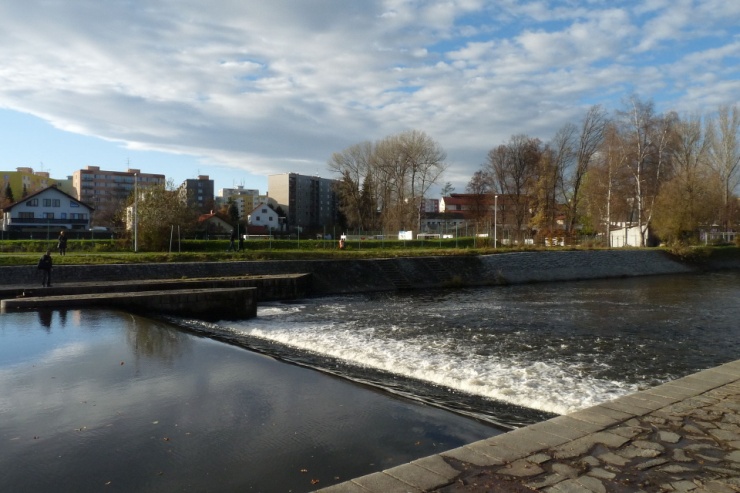
- The state owns the riverbed, there are no additional purchases of real estate and land.
- Building permits are obtained quickly, because there are no legal obstacles to co-ownership of property.
- Coastal land is not disturbed; cascade hydroelectric power plants are in the riverbed.
- The built communications on the river bank are not disturbed.
- The already known water resource is used, which is very suitable due to the anticipated amount of energy we have at our disposal from precipitation, the expected contact of water through the river basin.
- When the type of hydro turbine production is adopted, serial factory production (type construction) is done.
- Many unit positions of the setting in the riverbed (construction is accelerating several times compared to the construction of conventional hydropower plants).
- Unused resource of lowland rivers is being exploited.
- Due to the lower hydrodynamic pressure, the mentioned favorable backfill dams and embankments can be used.
- Favorable type maintenance (part is serially changed within 24 hours per position).
- Compared to the wind farm, the cascade hydroelectric power plant has the same construction price per MW, with the fact that it has a higher annual production of electricity at the time when we need it.
- Sedimentation does not stop, as is the case with conventional hydropower plants.
- Investment in this concept of green energy is sustainable in the long run and as such has the potential of typical river basin development with surrounding areas and industrial zones.
- Loans have stable financing from the mentioned, faster construction, faster earnings. For the started part of the project, it repays itself and finances the future section of hydroelectric power plants along the river course.
Expensive construction of conventional hydropower plants
Extensive preparatory works are needed, such as partial partitioning of the river, purchase of land, relocation of built roads, reclamation of coastal land. All the above takes a lot of time.
Then, extensive and expensive reinforced concrete construction works are performed on the formed construction site.
Every classic hydroelectric power plant is universal, while cascade hydroelectric power plants are built in a typical way.
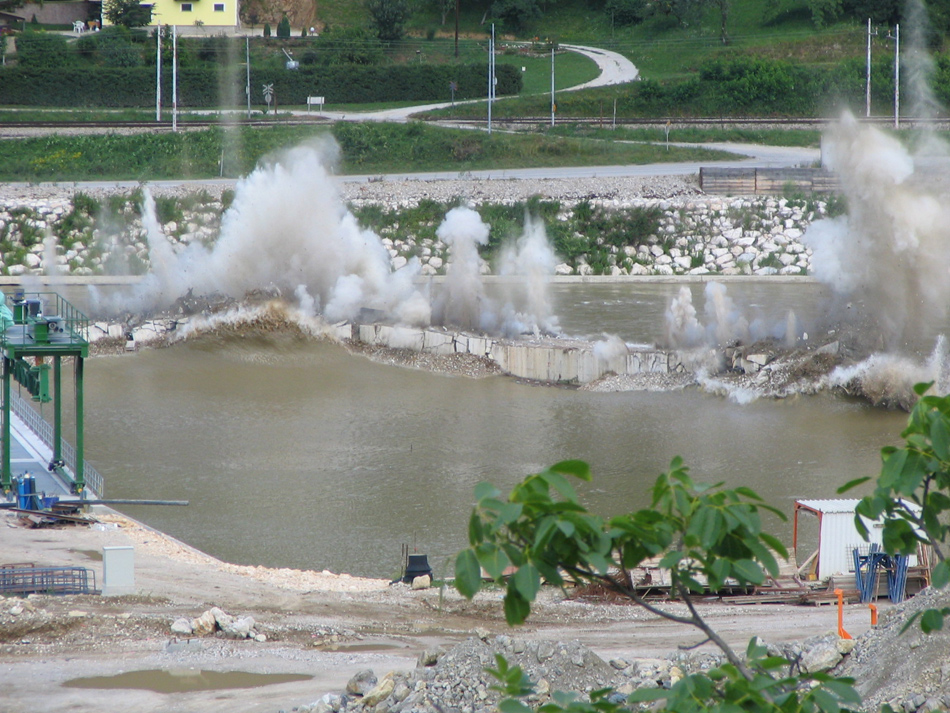
With the completion of the works on the construction of the classic hydroelectric power plant, the remains of the construction site security will be removed.
Cascade hydroelectric power plants are made in series, their price then decreases because they are of the prefabricated dismantling type, factory production. They are installed in a short time on piles with factory elements and strip foundations. For the installation of a cascade hydroelectric power plant, it is not necessary to divide the river in such an expensive way, but barges with appropriate mechanization and equipment.
Construction of a cascade hydroelectric power plant in the city of Osijek/Croatia
The cascade hydroelectric power plant can be built in the city itself, next to NK Osijek.
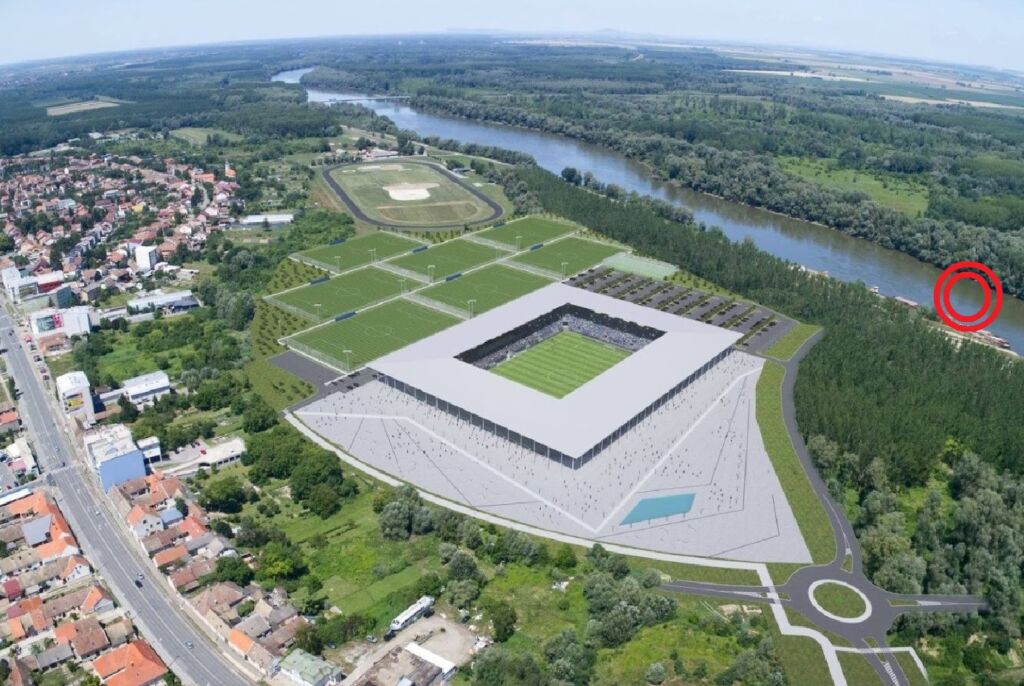
At this point, a cascade hydropower plant may have a planned water deceleration of 3,12 m.
With the installation site of the cascade hydroelectric power plant, it would have an installed capacity of 16 MW.
I would use max. water flow of 700 m³/s.
A waterfall over 300 m long would overflow high water, with a planned additional flow above 2,400 m³/s.
The cascade hydroelectric power plant itself would be equipped with additional tourist and sports facilities.
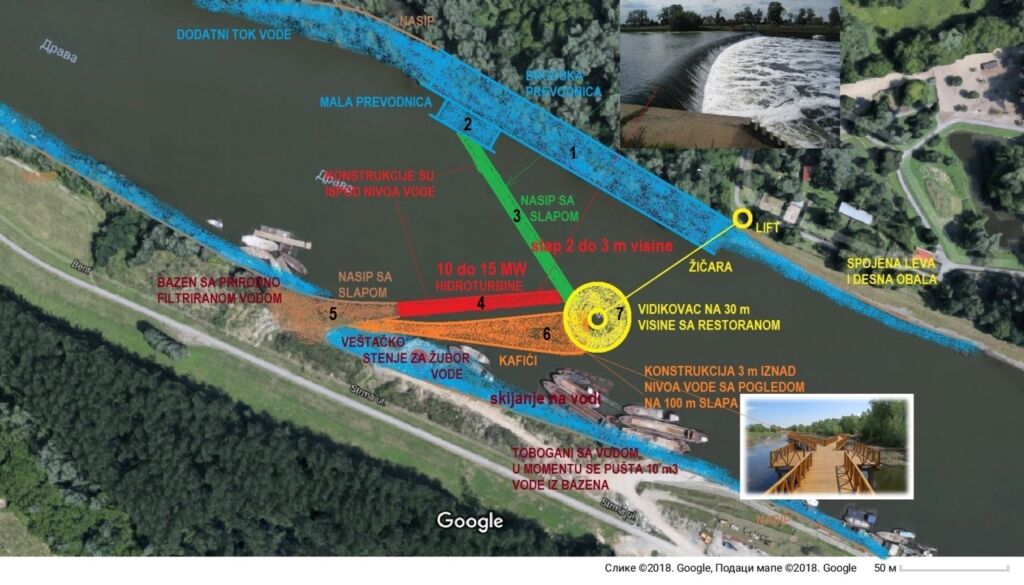
Necessary positions of the cascade hydroelectric power plant on the site next to NK Osijek:
- The ship’s lock would be buried in the current left bank of the Drava River and would be 1 m above the upper water level and 4.12 m above the lower water level, lined with decorative stone;
- A small boat lock will be 1 m above the water level, lined with decorative stone;
- The embankment with the waterfall is automatically regulated by variable height, and located completely below the upper water level;
- Hydro turbines are automatically regulated with a change in the height of the overflow, located below the upper water level;
- The coastal embankment with a waterfall is located along the coast, covered with a coastal fortification which is at the level of the promenade.
Additional content for the needs of catering and tourism:
- Pier with catering facilities, which are located 2.5 m above the upper water level, next to hydro turbines;
- A lookout with a restaurant, located 30 m above the lower water level, made in a glass dome;
- The stay is refreshed by the constant breeze at that height, the view of the hydroelectric power plant and the city from the rotating dome;
- lifts with a cable car, which attractively transport tourists 30 m above the cascading hydroelectric power plant, from one coast to another.
Sports and recreation, additional content:
- A pool in which water from the upper part of the river is naturally filtered, for the purpose of safe swimming;
- Ten water slides, where 10 m³ of water is occasionally released from the pool. A swimmer with a large amount of water moves at a speed of 3 m/s for up to 50 m;
- Water skiing is provided by water intake with pipes from water deceleration, water speed on the serpentine is 5 m/s;
- Artificial rock causes occasional and controlled, beautiful murmur of water in streams with colorful lighting.
The planned slowdown of water with the installation of a cascade hydroelectric power plant near NK Osijek would enable a constant and controlled water level in the city of Osijek. Like so, the water level would visually enrich the space of the promenade, the area of the city in the length of several kilometers. Then it would be a pleasant and safe walk by the water, the existing coastal fortification. The water level in the city would be maintained as shown in the picture, regardless of the amount of water flowing along the Drava River.
Safe and constant navigation through the city of Osijek, tourist, commercial and small vessels would be enabled.
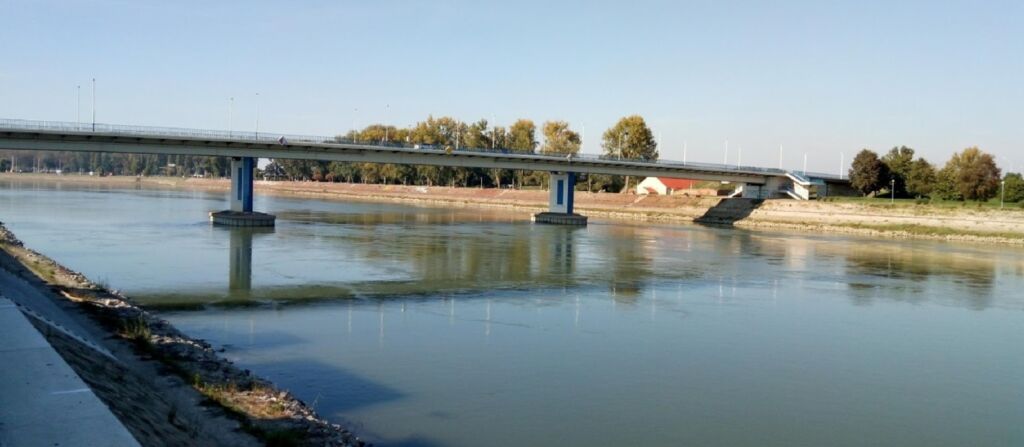
The built cascade hydroelectric power plant on the site of NK Osijek would control the slowdown of water that would cover the mud and part of the fortified coast. This would prevent the evaporation of bio gases and unpleasant odors, which are caused by contact of sedimentary biomaterial with atmospheric air. Certainly, it would be a much nicer view of the Drava riverbed.
Cascade hydropower plants, note:
- By-product of construction is reclamation of coastal land along the river, new arable land with planned irrigation;
- A stable riverbed was obtained without the possibility of meandering the river, useful for the urban development of settlements along the river;
- Cascade hydropower plant of 16 MW is built within 12 months, fast construction;
- By-product of the cascade of rivers has a constant navigability throughout the year, regardless of the amount of precipitation;
- Existing reservoirs can completely stop the flow of water at night, so that cascading hydropower plants can operate in daytime at peak electricity consumption. The operating mode thus corresponds to the existing hydroelectric power plants with reservoirs. Production is mostly daily or as needed;
- Water overflowing over artificial waterfalls in the cascade is transferred daily to a distance over 500 km, which does not allow the concentration and proliferation of flood water in the affected area (no floods);
- The ecology of the river will be fully respected, by automatically controlling the water level per centimeter. Fish hatcheries are always provided with running water, water leveling as needed by the nature park.
Project parameters for the construction of the cascade hydroelectric power plant NK Osijek
- future total installed capacity is 16 MW;
- expected annual average production is 64,000 MWh;
- cascade hydropower plants have a difference in useful water drop height of 3,12 m;
- cascade hydropower plant has 32 hydro turbines;
- water outlet speed at the lower part of the hydro turbine is automatically controlled at 3 m/s;
- cascade hydropower plant has generators located below the water surface, power 8 x 2 MW;
- cascade hydroelectric power plant has eight engine rooms, located below the river surface;
- cascade hydroelectric power plant has one large conduit, located along the river bank;
- cascade hydroelectric power plant has one small conduit, located along the river bank;
- maximum useful flow through one cascade hydropower plant is 700 m³/s of water;
- additional excess water, periodically from flood waves crosses the waterfall up to 2,400 m³/s;
- the length of the waterfall, cascading overflow is 300 m (700 + 2,400 = maximum flow is 3,100 m³/s of water);
- the height of the waterfall, cascading overflow is up to 1.6 m, where the average flow speed is approximately 5 m/s;
- at the place of installation of locks, the passage of high waters is additionally enabled;
- cascade hydropower plants can stop the flow of water during the night, then the flow in the river is 0 m³/s;
- the minimum operating flow through one cascade hydropower plant is 50 m³/s;
- the expected average annual flow of the Drava River is above 380 m³/s, mostly daily water flow is used;
- generators are asynchronous with a line voltage of 400 V;
- the torque of the generator is 750 rpm, which is assisted by the flywheel;
- direct transfer of mechanical energy to the generator is done, without reducer;
- the ratio of mechanical energy transfer from the hydro turbine to the generator is 1: 8 via the shaft, self-adjusting;
- parameters are controlled and adjusted by automation with the help of several technical solutions;
- height of hydro turbine adjustment with water column, from minus 1.5 m to plus 1.5 m, oscillation 3 m;
- electricity production is directly delivered to the local electricity grid, consumers.
Cascade hydro turbine is made of stainless steel, which is mostly processed by pressing, puncturing and welding (does not require additional painting), the material is durable, so that the hydro turbine can be used for years.
The material, as well as the concrete housing, is resistant to the abrasive effects of sediment movement in the river, through the hydro turbine.
Cascade hydroelectric power plants on the river Crni Drim
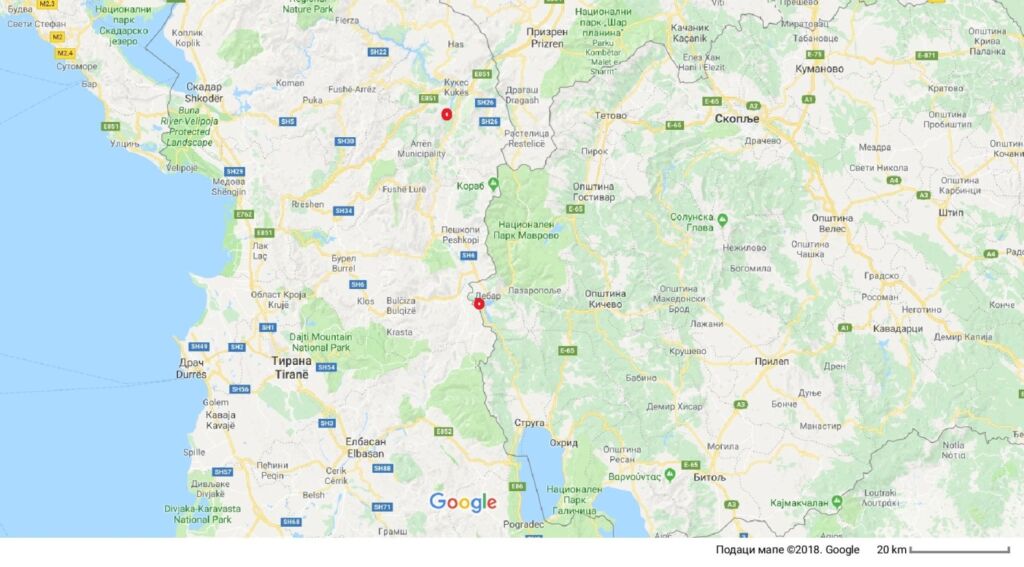
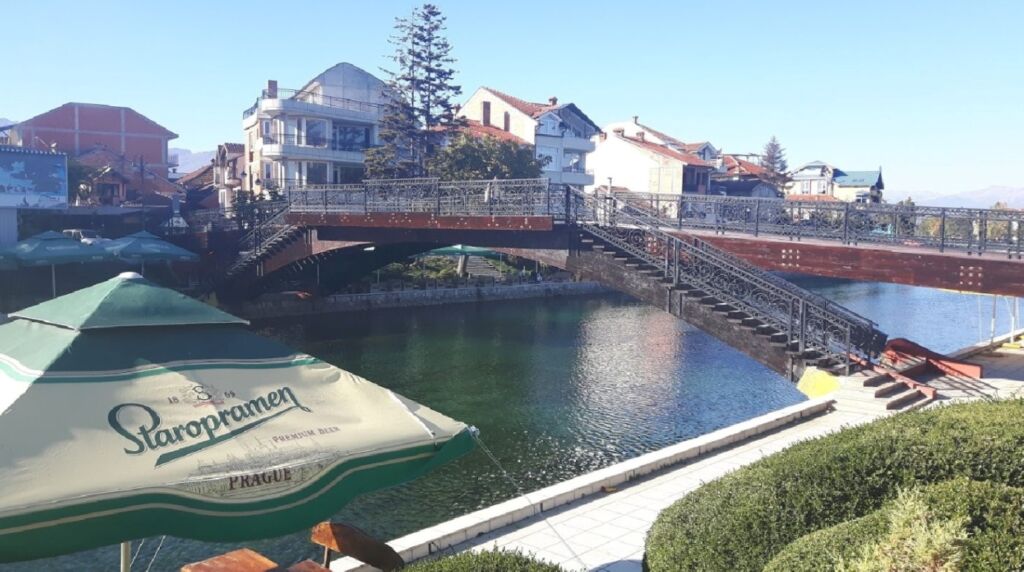
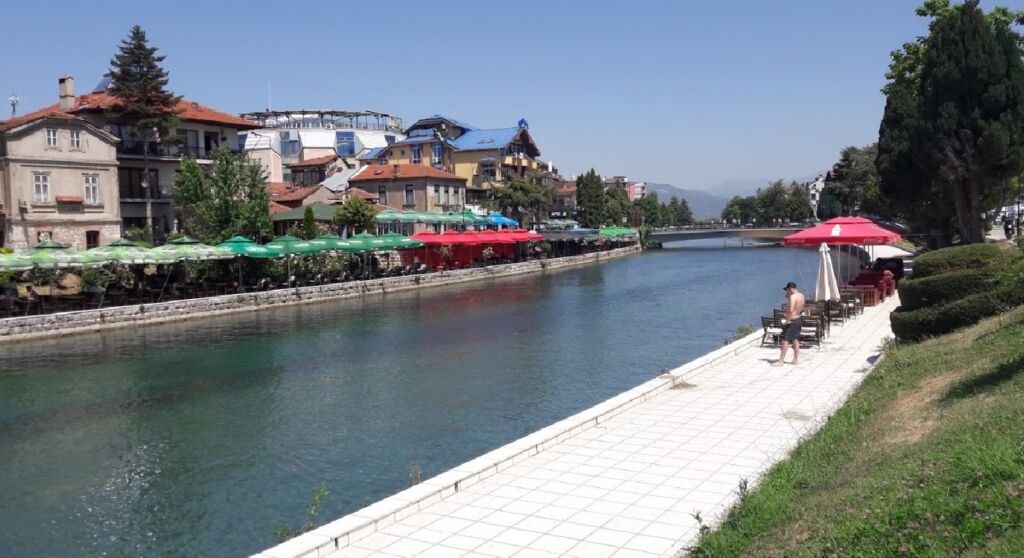
- The river Crni Drim originates at the outlet of water from Lake Ohrid, at an altitude of 693 m;
- In the upper course of the river Crni Drim, two hydroelectric power plants with reservoirs were built, HPP Globočica and HPP Špilje;
- Constructed reservoirs with Lake Ohrid provide favorable parameters for the use of water in the downstream, and for the needs of regular operation of future cascade hydropower plants in the Crni Drim riverbed;
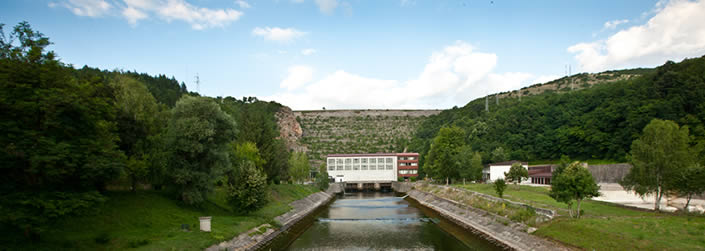
- The water level in the Crni Drim riverbed, below the HPP Špilja dam is at the level of 485 m above sea level;
- The water level at the outlet of HPP Špilje is at the level of 482 m above sea level;
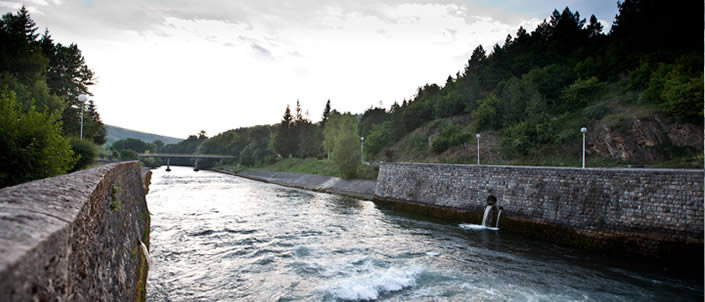
- HPP Špilje has an installed capacity of 3 x 28 MW = 84 MW;
- HPP Špilje uses a water column of 85 m;
- HPP Špilje uses water flow 3 x 36 = 108 m³/s;
- Annual production of HPP Špilje is:
2000 years = 377.000 MWh;
2003 years = 378.000 MWh;
2004 years = 448.000 MWh;
2005 years = 426.000 MWh;
2006 years = 424.000 MWh;
2007 years = 356.000 MWh;
- With 1 MW installed in the upper course of the Crni Drim River at the site of HPP Špilje, the hydro potential has been proven with an annual electricity production of on average from 4000 to 5000 MWh.
- Future cascade hydro power plants may have an installation parameter, 1 MW per 1 m of river fall;
- The advantages are also smaller streams and rivers, which flow into the downstream section of the river Crni Drim.
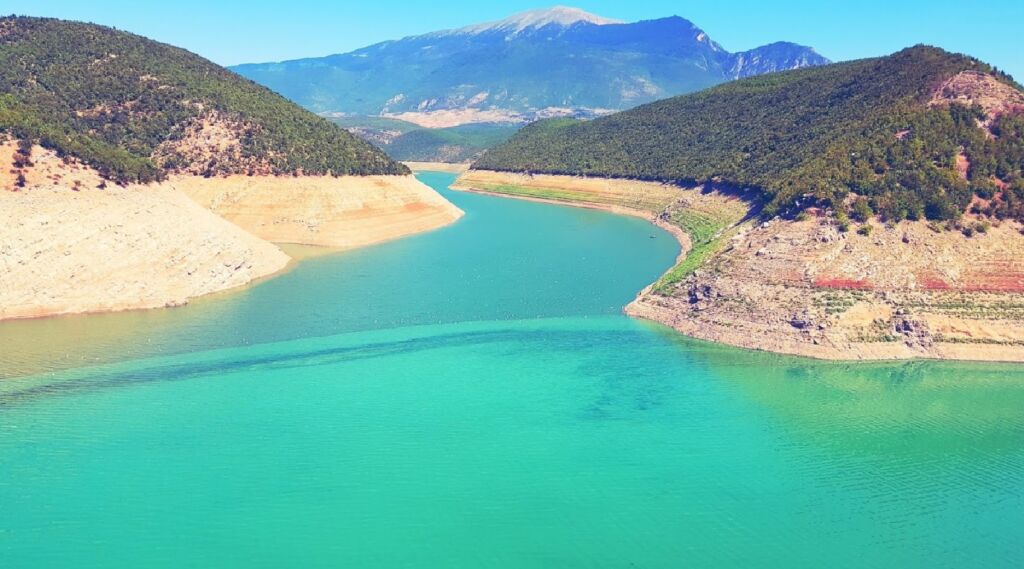
- 4 hydroelectric power plants with reservoirs were built in the lower course of the river Crni Drim;
- The picture shows the upper reservoir, where the level of the Fierza lake oscillates at an elevation of 280 m above sea level;
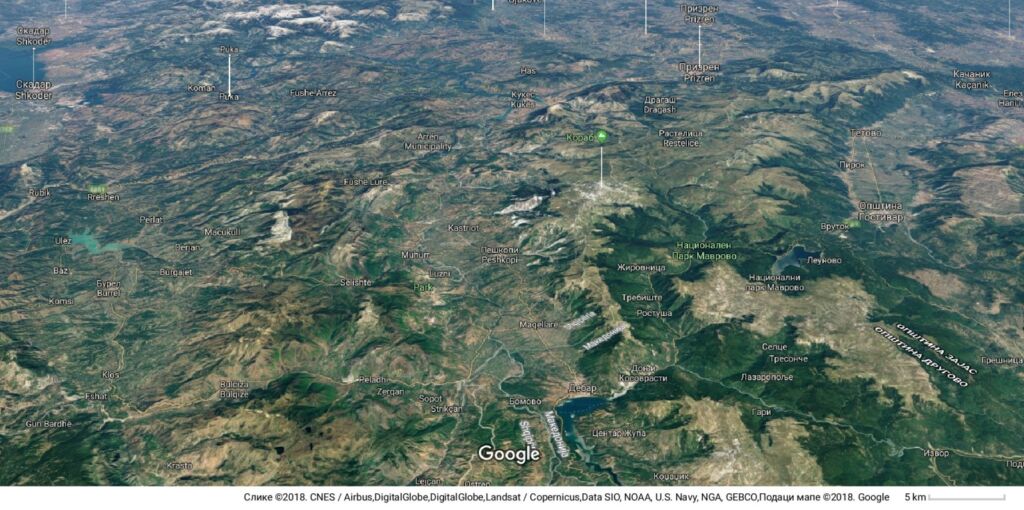
- Construction of 200 MW of cascade hydropower plants would take 2 to 3 years;
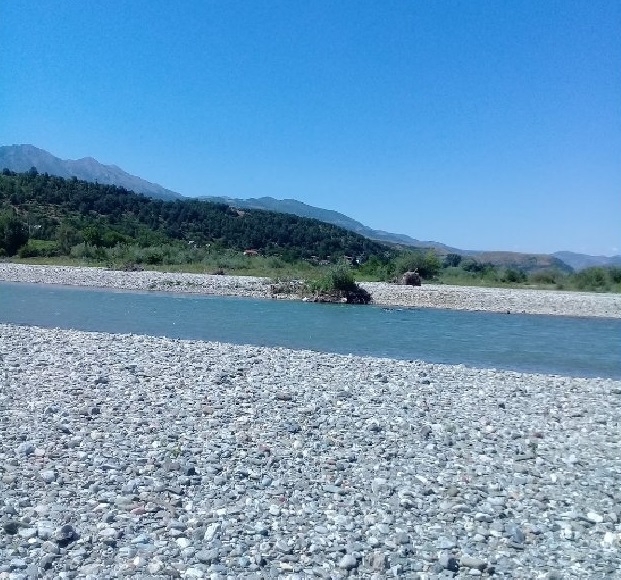
Natural material and sediment from the riverbed would be used for the fortification and construction of the cascade (picture attached).
Display of parts of a cascade hydroelectric power plant
